Deja Vu – A Plane Spotting Challenge by John Madden
Catch up on the previous reports from this challenge:
Introduction
Trip Report #1
Trip Report #2
Trip Report #3
Trip Report #4
Trip Report #5
Trip Report #6
Trip Report #7
*Trip Report #8
I kicked off the New Year by spending one dark miserable January evening re-acquainting myself with the 7 spotting trip reports that I have shared with you since July 2020. It is three years since that defining moment in Barbados when sipping a rum with my good friend Mount Gay that I decided to embark upon the challenge of a life time, spotting one of every aircraft type built since 1939 capable of carrying 9 passengers. Much has happened since that magical moment, but I can honestly say that the desire to continue with this wonderful but crazy challenge is as much alive today as it was then. So much so that on that miserable evening last January I decided 2023 must include a spotting trip that would create a sizable dent in the list of aircraft remaining as part of the challenge.
So here we are, my 8th spotting trip and one that will take me back to a number of airports that I have not visited in over 40 years. Returning to Canada and the USA, albeit a microcosm of the vast landscape we refer to as North America, really does feel like a proper case of “deja vu”. With only 7 days on hand, the trip includes 1,892 miles, 6 different beds, 5 Great Lakes, 16 airports and a truly memorable “pinch me” moment on the very last day.

Spotting trip route including major airports visited
I first visited Canada with my parents in 1968 and although not a spotter at the time, I do remember seeing rows of Air Canada Vickers Viscounts and Douglas DC-9s through the window of our World Airways Boeing 707 as it taxied to the stand. I returned to Canada several times during the late 1970s and early 1980s, and having now discovered the world of “spotting” I spent many an hour at Toronto and Buffalo airports. Although Toronto offered a more diverse range of airlines and aircraft types, Buffalo remained my favourite go to spotting place as I was able to get really close up to the Allegheny Beech 99, BAC 1-11, Convair 580 and Shorts SD-330 aircraft on the ramp. Looking back at some of the photographs taken 40 years ago, it strikes me just how close to the aircraft I was able to stand to the aircraft. A privilege no doubt long gone in this modern era of aircraft spotting, or has it? This is something I have pondered many times during the lead up to this trip, and I wait with bated breath to see just how close I can get to the aircraft this time around.
One of my Canadian cousins relocated from Southern Ontario to Detroit in the early 1980s, providing the opportunity to visit the many airports located in southern Michigan. This was when I discovered Willow Run Airport; home to the numerous airlines that supported the vast US motor car manufacturing industry located in and around Detroit. On my last visit to the airport in 1982, I logged in excess of 20 Douglas DC6s, along with 4 Lockheed Electras and 3 Curtis C46s. Sadly, Zantop Airlines and many of the smaller cargo operators of that time have disappeared, but I do expect to see a number of interesting aircraft belonging to the current cohort of airlines that have taken over this very important supply chain operation.
Whilst not expecting any Douglas DC6s, Lockheed Electras or BAC 1-11s to make an appearance, I do anticipate spotting a good number of “live” Boeing and Douglas Classic jetliners supporting not just the motor car industry but also the remote mining and indigenous communities scattered across Northern Canada. This trip takes us away from the large cities and into the domain of the many bush planes that still fly for a living in the splendour of the great Canadian wilderness.
As with a number of my previous trip reports, this one also includes several aviation museums, without which my challenge would be impossible to fulfil. Before researching the aircraft collections to be visited on this trip, I did not realise that I would be blessed with so many types I barely knew still existed. In addition to the obvious major hubs, the itinerary includes a healthy mix of municipal airports, and one private airport that does not feature in FlighRadar24. All the airports visited, irrespective of size and or number of movements, delivered an eclectic mix of aircraft types and genres that should appeal to all.
So, before I share my latest trip report, what if anything has happened to me from a spotting perspective? Something seismic actually! Retirement doesn’t really suit me or perhaps it doesn’t suit my wife. Whatever the reason, I was encouraged to find a part time job, which I have dutifully done and I now work 3 days a week at Heathrow. A dream come true, not only a job at an airport but more importantly one that allows me to work airside across all 4 terminals. More importantly, I am able to fulfil my duties whilst managing to fit in a fair amount of spotting. A month or so after starting work, my son asked me if my love for the hobby had waned now that I am surrounded by aircraft all day. Honestly, I would go as far as to say that I am more in love with spotting than ever before. The only downside of the new job is that I have developed a severe case of “swivel neck”, although I am happy to accept this ailment as an occupational hazard of working at Heathrow.
As is customary before jetting off, I will share a couple of my stand out spotting moments since the last trip report. The first, surprisingly did not occur at Heathrow, but directly over my house on 11th October 2022. Having returned home from work, I parked the car and looked upwards at a clear blue sky in anticipation of seeing an over flight. With only the naked eye to assist with identification, I thought that I had spotted an A380 approaching from the South East. As the aircraft passed over head, I realised that in fact it was a Boeing Dreamlifter, a type that I didn’t expect to spot so early on in this challenge. Not only was this a Boeing Dreamlifter, but I discovered the next day that it was the very aircraft that left a wheel on the runway at Taranto airport having departed Italy for Charleston. Not your everyday spot, in more ways than one.
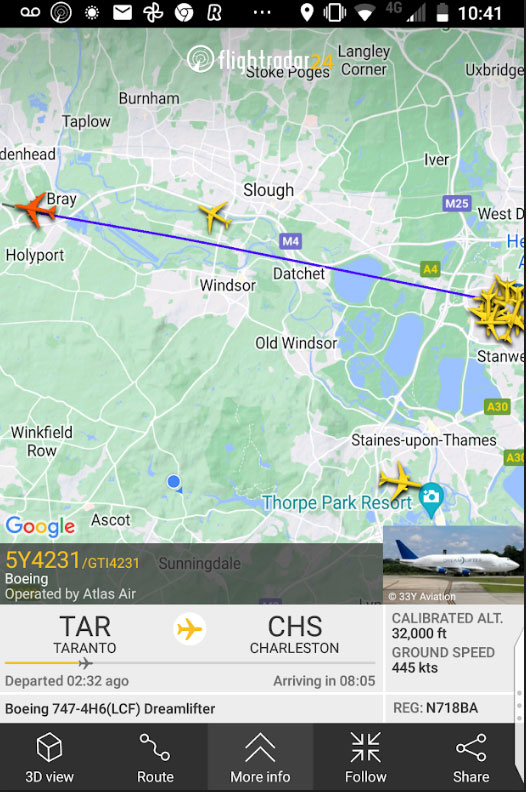
The second significant spotting moment did happen whilst at work and just days before I submitted this trip report for publishing. The long passenger walkway to gates 13-22 at Terminal 3 provides a magnificent view across the southerly runway and particularly the VIP ramp. To my surprise Airbus A340-500 A7-HHH was parked on the VIP ramp, finally allowing me to complete the Airbus section of this spotting challenge. I have mentioned in previous reports that I have a particular penchant for the Airbus A340 family, so for this variant to go down as the final Airbus aircraft type spotted was quite apt.
Heathrow Friday 12th May – Wheels-up 08:30, runway 27R
This is the first occasion that I have flown from Heathrow since taking up employment at the airport, and it did feel rather strange travelling to Terminal 2 as a passenger and to somewhere that most definitely feels like the “office”. Having dealt with this strange new feeling I settled down at an advantage point close to our departure gate and discretely did some leisurely spotting with a friend who would accompany me on this trip. Thankfully Mr. Jones is of similar aviation disposition and not only could he be relied upon to do his fair share of the “pencil work” at the many airports on the trip itinerary, but also be there to help keep the ship steady on this 7-day spotting roller coaster.
One aircraft that particularly caught our eye before we departed for Canada was One Air Boeing 747 400F G-NUET, parked on the cargo ramp on the south side of the airport. Quite fitting actually as today we are flying with Air Canada and this specific Boeing 747 was delivered new to the airline in 1993 and later converted for cargo use in 2006. What has struck me most since working at the airport is the complete dearth of Boeing 747 movements, and it was a moment of joy to see a new British Airline picking up the mantle of maintaining more than 50 years of “jumbo” operations at Heathrow. Sadly, our steer for today’s flight to Toronto is not an Air Canada Boeing 747 but Boeing 787-8 C-GHQQ.
After an uneventful flight to Toronto, although that evening it became very clear just how eventful the flight actually had been, we hit the QEW at 13:00 local time and headed south to Hamilton, the first designated spotting venue of the trip. So, what made the flight from Heathrow to Toronto so eventful after the event? My trip buddy left his wallet, complete with credit cards, on the aircraft. Now the cynic may suggest what a stroke of genius on his behalf, but I have known Neil for over half a century and we both did see the comical side of his miss fortune. Toronto airport was awash with modern jetliners but the standout aircraft for us as we departed for Hamilton was Antonov AN-124 RA-82078 which has been resident since Canada closed its airspace to Russian registered aircraft on 27th February 2022.
Hamilton Airport – the unexpected Classic.
There are two reasons for including Hamilton Airport on this spotting itinerary. Firstly, the Canadian Warplane Heritage Museum with its DHC-5 Buffalo required as part of my challenge, and secondly, the fine array of resident cargo airlines. Upon arrival at the airport, we headed straight for the cargo ramp and parked behind Puralator DHC8-100 C-FGRP, the first aircraft of the trip to be removed from the challenge list. The ramp shot below also includes the first of 15 Boeing 727 aircraft logged on this trip, N251FL belonging to the local Mohawk University.
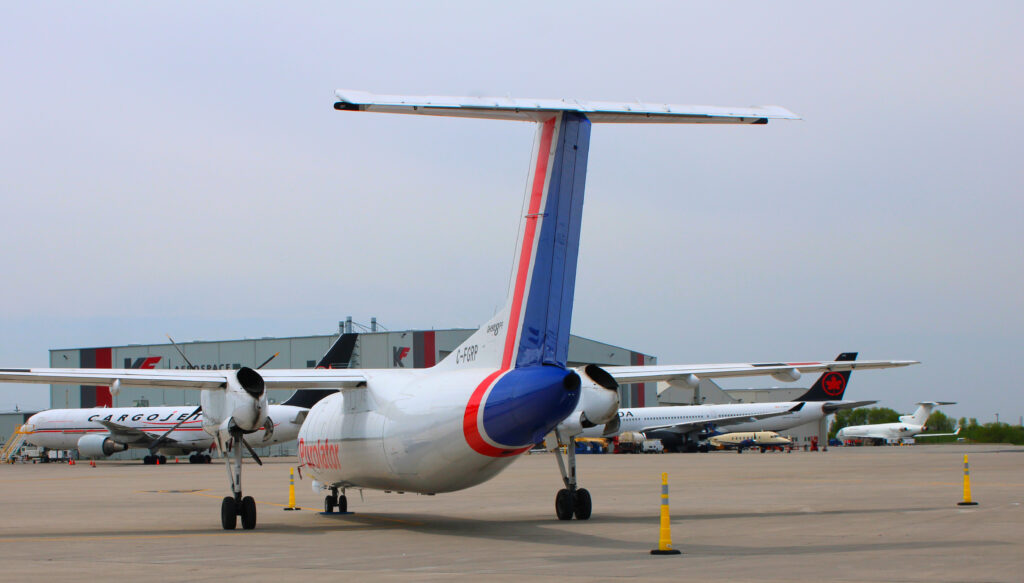
The following photographs were all taken from different staff car parks that line the numerous cargo ramps at the airport, providing close up views of the aircraft parked for loading and unloading purposes. We were reliably informed that Avianca A320 N685TA was in for maintenance purposes, still wearing the US registration assigned to the aircraft when flown by former owner TACA. We didn’t witness the Chrono Aviation Boeing 737-200 C-FYPN arrive, but the hive of activity you can see in the photograph relates to several VIPs who transferred from the aircraft onto an awaiting helicopter. I had expected to see a Chrono Aviation Boeing 737-200 but not in Ontario, so this was a most unexpected but very welcome visitor and the first of 8 Boeing 737-200 aircraft logged.
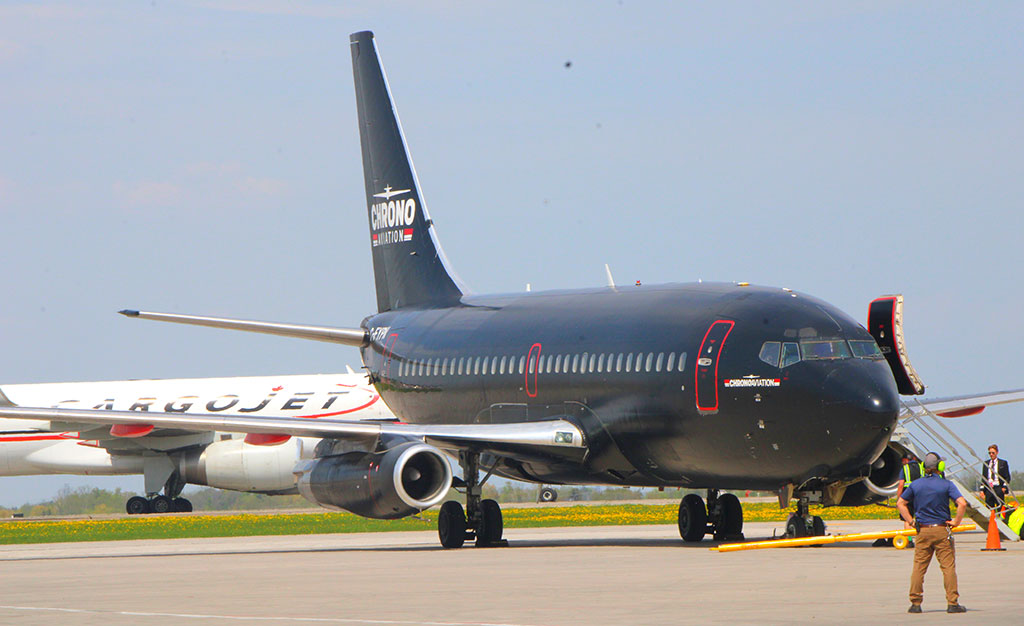
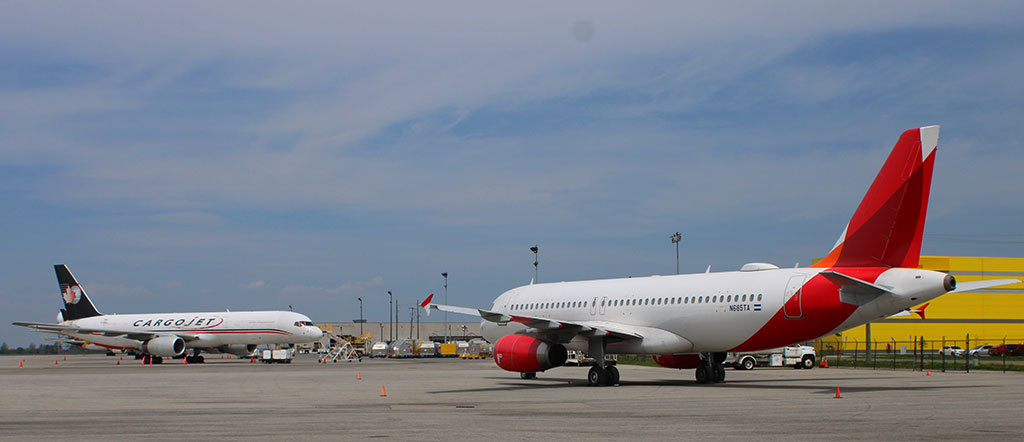
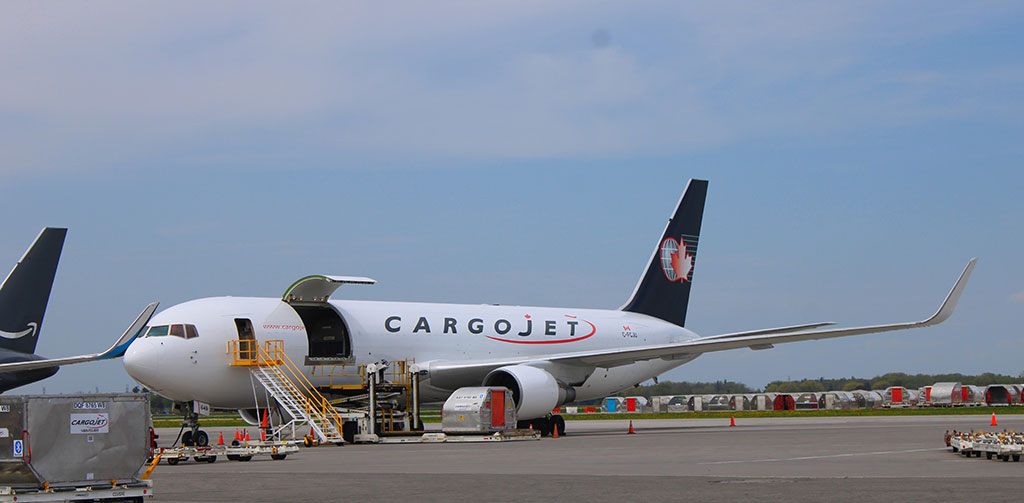
Desperate for a cup of tea and a muffin, we headed for the Museum where I would be able to spot the resident DHC-5 Buffalo. The aircraft on display is former Sudanese Air Force example 811, but now registered as RCAF example 115461 wearing full UN livery. The registration and livery combination have specifically been chosen by the Museum as a tribute to the RCAF aircraft of that registration which was shot down over Syria whilst on humanitarian duties in 1974, sadly with the loss of all on board.
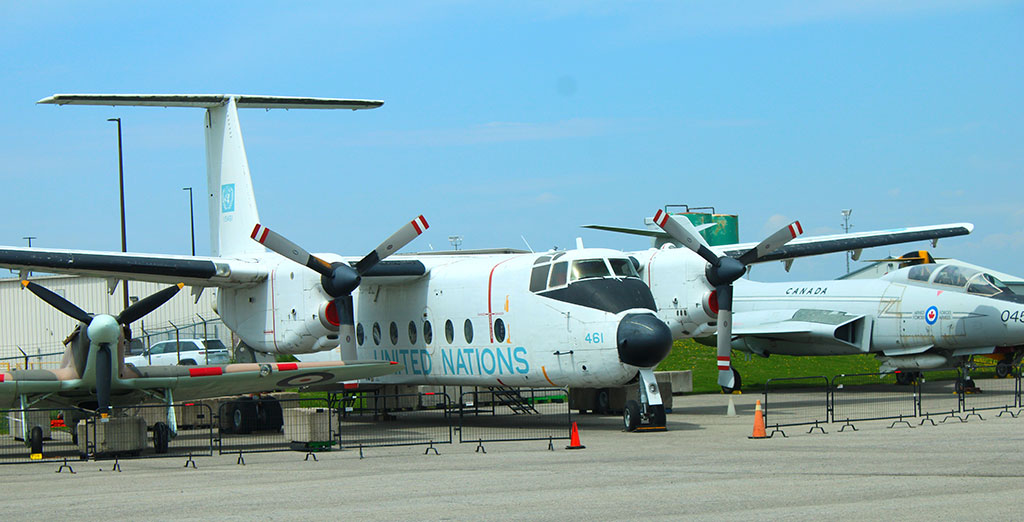
Whilst not part of the challenge, the Museum also provided a Noorduyn Norsman and RCAF Cessna Crane, both of which were aircraft types that I had not seen before. It was also very fitting that the Museum is home to RCAF Avro Lancaster FM213, one of only 2 remaining airworthy examples worldwide. The following Tuesday would be the 80th anniversary of the Dam Busters Raid, and it was clear to see that the Museum staff were busy preparing for a programme of activities in memory of the event.
We departed Hamilton and headed for Stevensville where I would be staying with my cousin for the next 2 nights. Things had started well indeed; 2 Boeing Classics and we had been spotting for less than 90 minutes.
“Motown” – Sunday 14th May
Having spent Friday evening and all-day Saturday with my relatives in Southern Ontario, we hit the road at 06:30 and headed west on the 4-hour road journey to Detroit. I am not going to hide how excited I felt as we crossed the border from Canada into the USA; I was truly intoxicated with anticipation as to what aviation gems this famous city would serve up.
Detroit Metropolitan Airport and “the unwanted child”
When I last visited Detroit Metro in 1985 the airport was dominated by North West Airlines, and today it has transformed into a Delta hub following the merger of the 2 airlines in 2006. I have not spotted a Boeing 717 since embarking upon this challenge and I was confident of seeing one during our visit to the airport. Not only was I gifted a Delta Boeing 717, but former AirTran N927AT dutifully taxied past the multi storey car park where we had chosen to locate ourselves during the brief stay at the airport. One has to look long and hard at this aircraft so as not to confuse it with a Douglas DC 9-30, and therein lies the reason for the demise of this type following Boeing’s acquisition of McDonald Douglas in 1997. As with all the other McDonald Douglas jetliners inherited in the merger, Boeing phased out this aircraft in favour of its own off-spring.
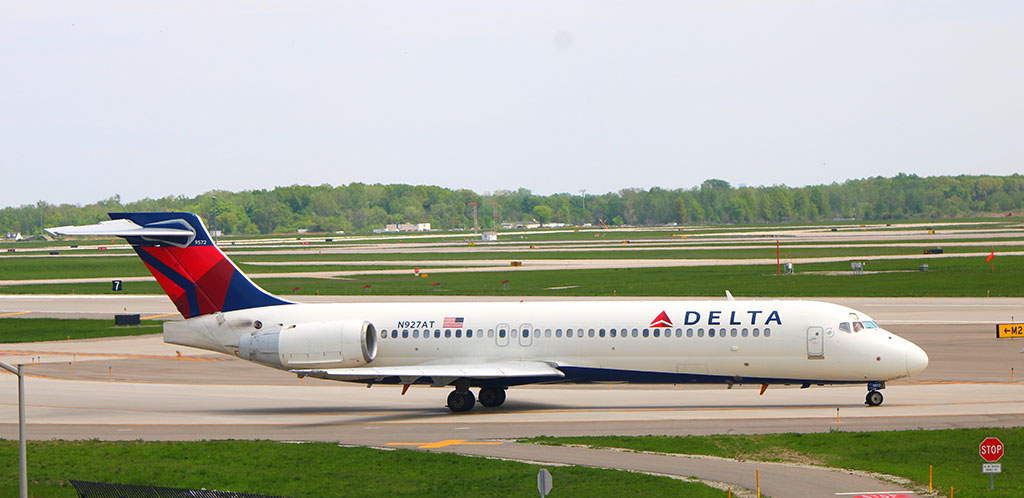
When comparing today’s log with that of 1984, it became very apparent just how much market share the US aviation industry has lost to overseas competitors. Albeit a straw poll and not wanting to become entangled in a political debate, the numbers are quite self-explanatory. The visit to Detroit Metro in 1984 lasted for around 90 minutes, a similar length of time to today’s visit, along with a similar sample size of aircraft. In 1984, 97% of the aircraft logged during that visit were of US manufacture, today that number had dropped to 37% with types from Airbus, Embraer and Bombardier/Canadair dominating the ramps. For the record, this theme continued to trend when we visited larger airports at the tail end of this spotting trip.
Detroit Willow Run Airport – Seniors most welcome
I have shared the spoils of my last visit to Willow Run 41 years ago; but what would greet us on Mother’s Day in North America? I mention Mother’s Day because we bumped into an avid Twitcher at the airport who was as surprised as us not to have been approached and questioned by airport Security as we methodically circumnavigated the perimeter fence. He explained that airport Security is normally quite strict and that anyone seen lingering around is swiftly moved on. Today he couldn’t believe how we could park up and photograph the extensive aircraft ramps without due hindrance, perhaps people’s minds were elsewhere on this much beloved day in North America?
Not a piston powered transport aircraft to be seen on this visit, but what a collection of US built Classic jetliners scattered across the four corners of the airport awaited us. For the record and from a “live” Classic aircraft point of view, we logged usajet Boeing 727-200 N725US, usajet McDonald Douglas MD-80s N831US, N834US, N8314US and N959DL (the latter departed for Laredo during our visit), Ameristar Boeing 737-200 N467TW and no less than 20 assorted Falcon 20/ LearJet aircraft belonging to Kalitta and or usajet. In addition, Douglas DC8-63 N658F was parked in front of the huge former WW2 B-24 Liberator manufacturing facility complete with engine in-take covers and not looking too shabby. The same could not be said for usajet Boeing 727 200 N727US, former North West Douglas DC9-30 and an unmarked Douglas DC9-10 all parked without engines and looking rather sad but never the less a delight to spot. The Douglas DC8-63 and Douglas DC9-10 were welcome deletions from the challenge list.
As for the reference to “seniors most welcome”, without exception each and everyone of the operational former jetliners at the airport today had seen more than 30 years service.
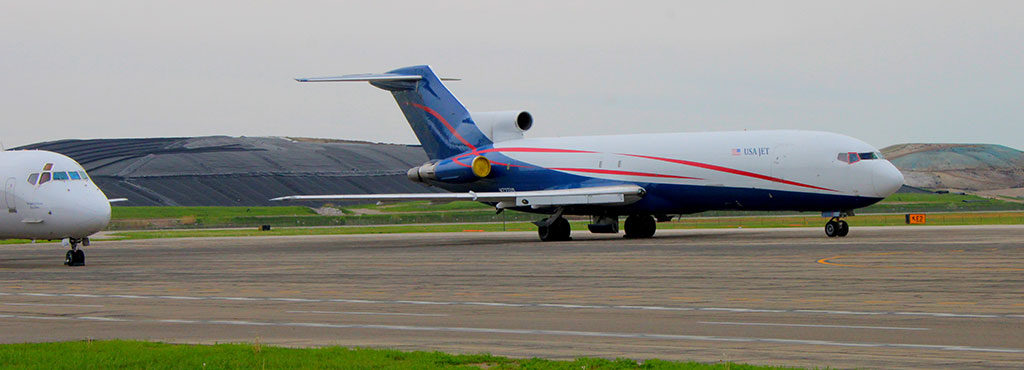
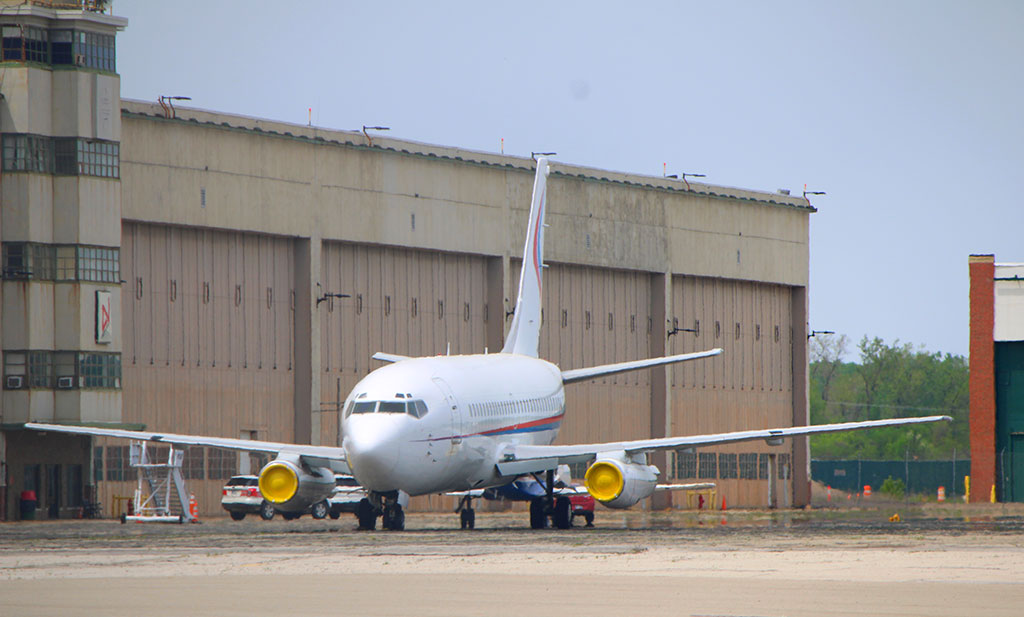
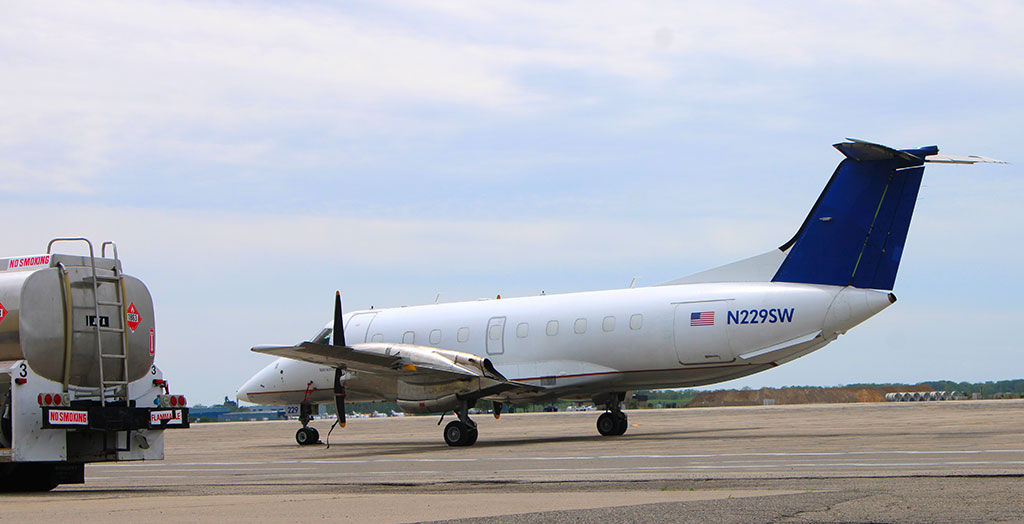
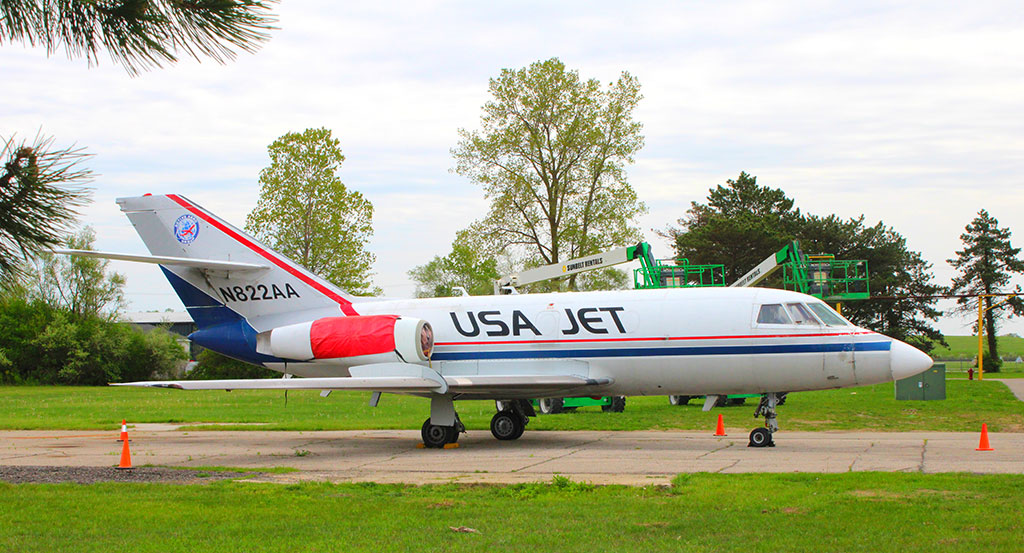
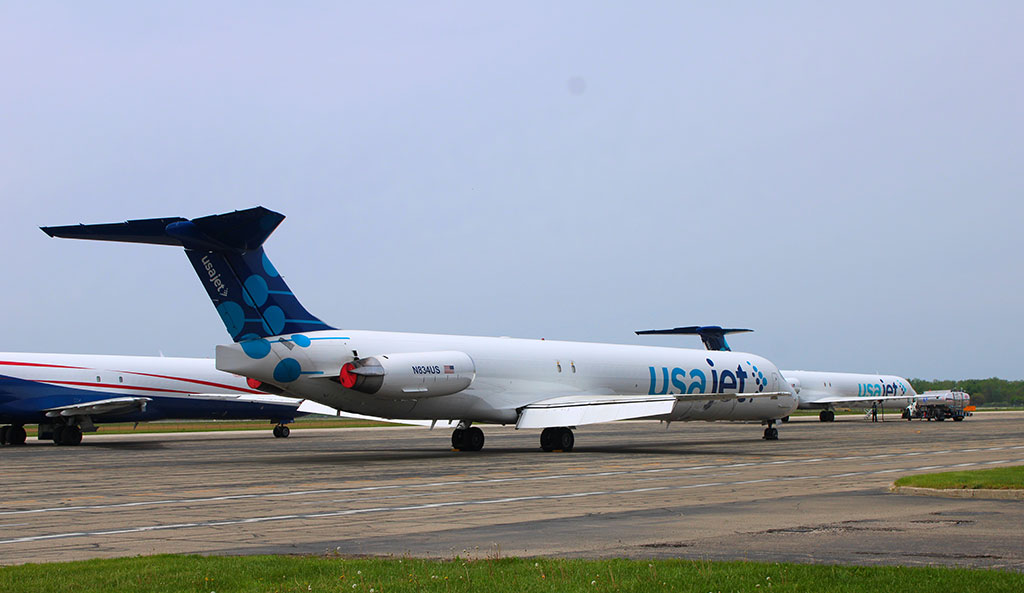
The airport is also home to the Yankee Museum which is instrumental in hosting the annual “Thunder Over Michigan” air show. Having viewed photographs from the last flying Day, I would certainly plan any future visit to the airport to coincide with this exciting aviation related event. This year’s show is scheduled for the weekend of 12/13th August and one not to be missed if you happen to in the hood.
Detroit Oakland/Pontiac – The “curse of the hanger”, episode one
Being only 30 minutes’ drive from my cousin’s house and our planned abode for the night, Pontiac/Oakland airport offered the potential to spot 3 much wanted aircraft on my challenge list. I was confident of spotting both the Royal Air Embraer EMB 110 Bandeirante and IFL Group Convair 580, but less confident of seeing one of the latter’s Convair 5800 aircraft which are based in Florida and venture North only periodically for maintenance purposes. As it transpired, both Convair variants were on the ground that afternoon but despite turning the airport upside down, we could not find a Bandeirante despite Flightradar24 stating that 3 examples were on the ground. The Royal Air hangers were all closed and kept their occupants from prying eyes, but the ramp did provide several Company Falcon 20s and Learjet 35s. I did feel rather disappointed leaving the airport without spotting a Bandeirante, perhaps Sunday is not the best day for small parcel related aircraft spotting?
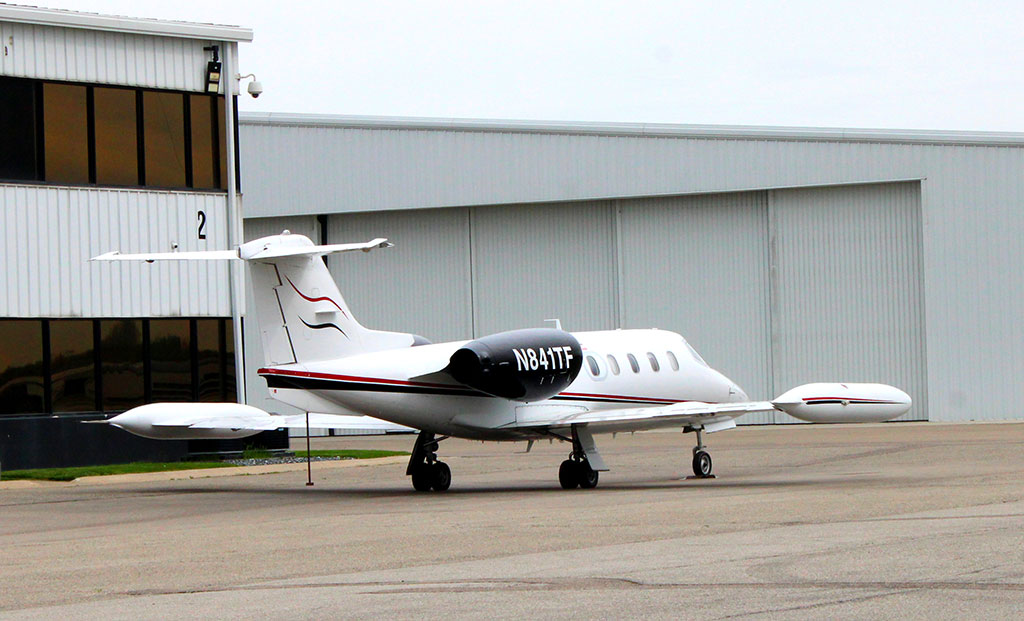
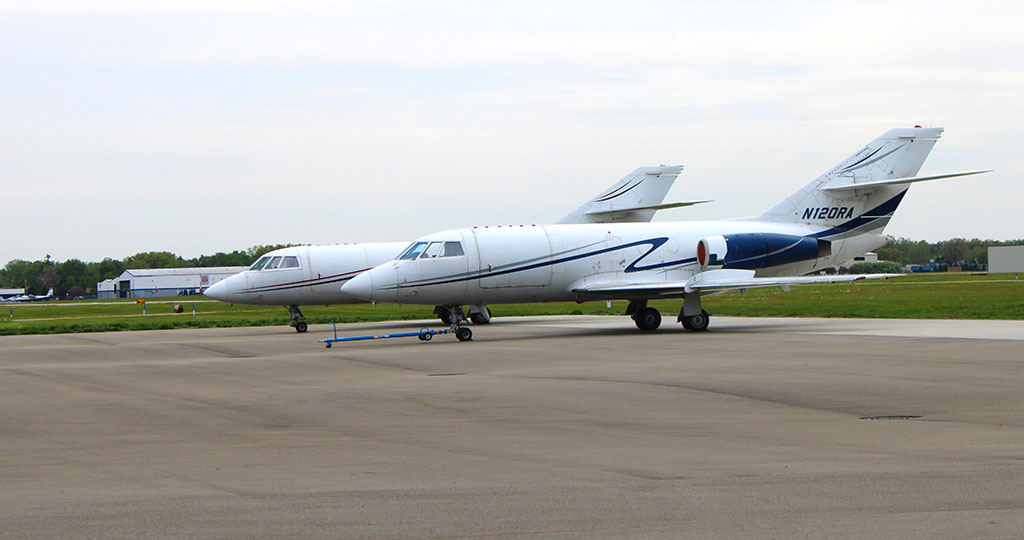
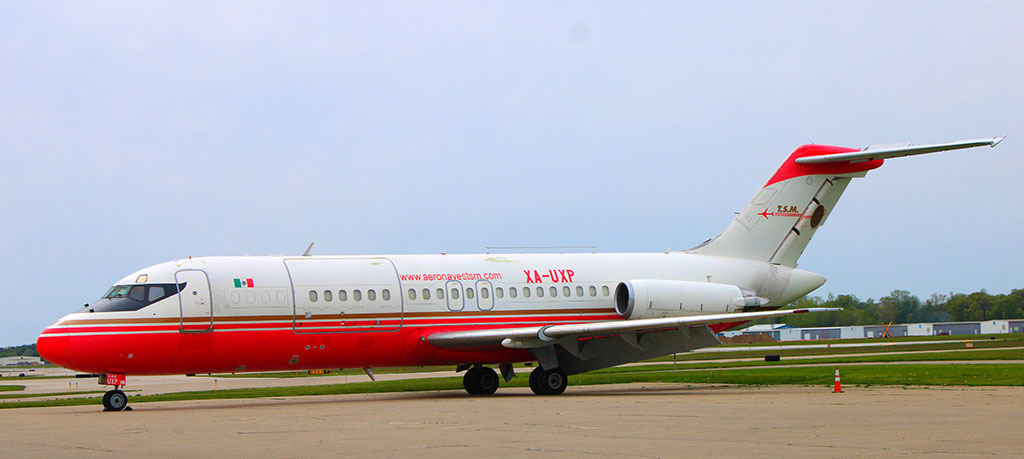
Despite not finding a Bandeirante, the airport did serve up Aeronaves Douglas DC9-15 XA-UXP, the second Douglas DC9 series 10/15 of the day! To ease the disappointment of not spotting the Embraer, the IFL Group ramp was awash with various aircraft including 3 operational Boeing 727-200s, 7 Convair 580s, CRJ 100 N821FL, several Falcon 20s and the much-prized Convair 5800 N391FL.
I was particularly pleased to see a ramp populated with so many Convair 580 aircraft, this took me back not only to former spotting trips to Buffalo airport and the resident Allegheny Airlines fleet, but also seeing the Great Lakes Convair 580s that once frequented Toronto airport.
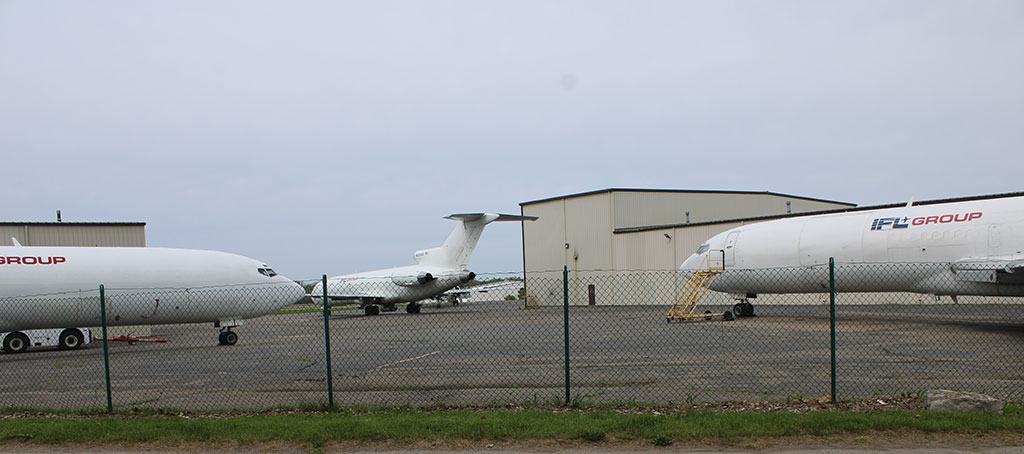
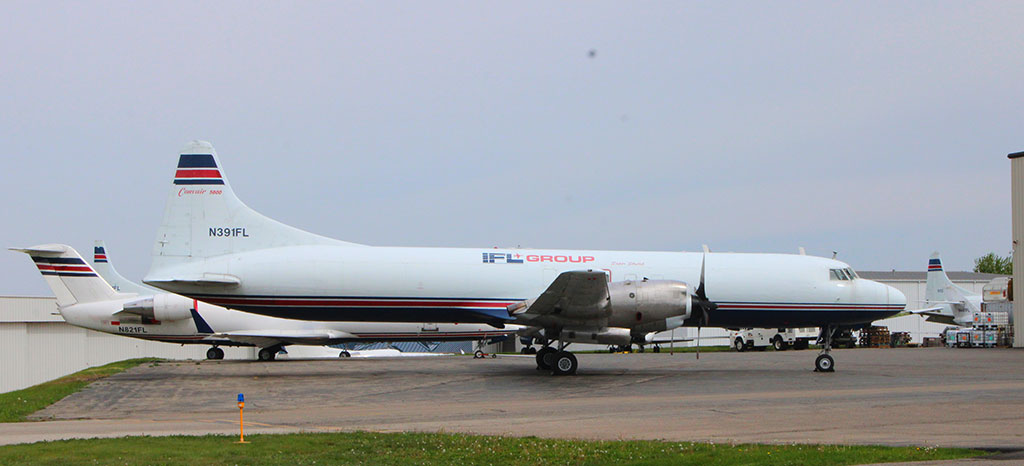
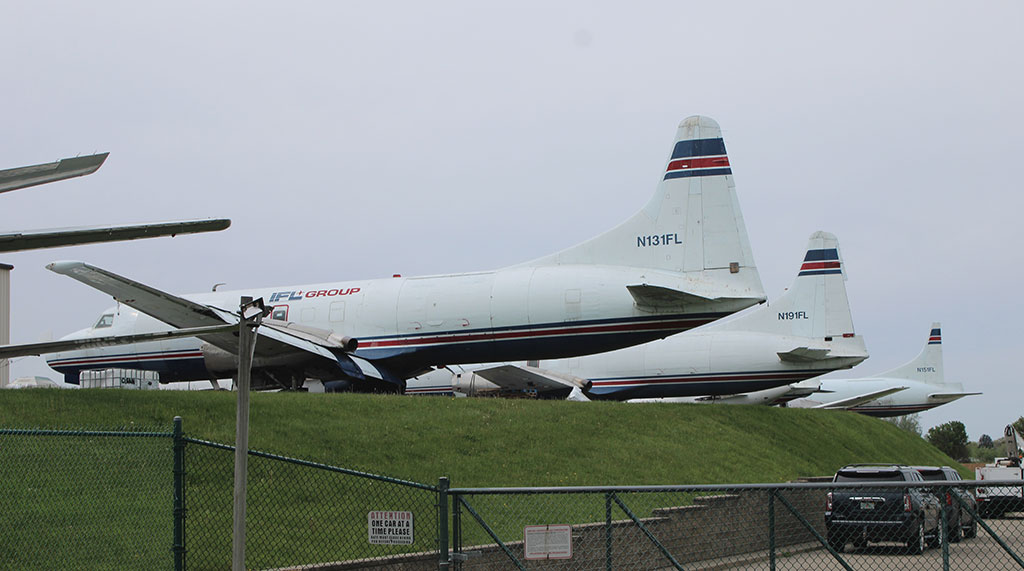
The airport also boasts a healthy Biz Jet community, particularly of the Hawker fraternity. Being the first Biz Jet type I ever logged, I am a bit of a softie for the “125 family” and could not resist including a photograph of one such example from this trip. For those familiar with the “Where’s Wally” book character, can you find the privately owned Fouga CM.170 Magister in the Hawker 800 photograph below?
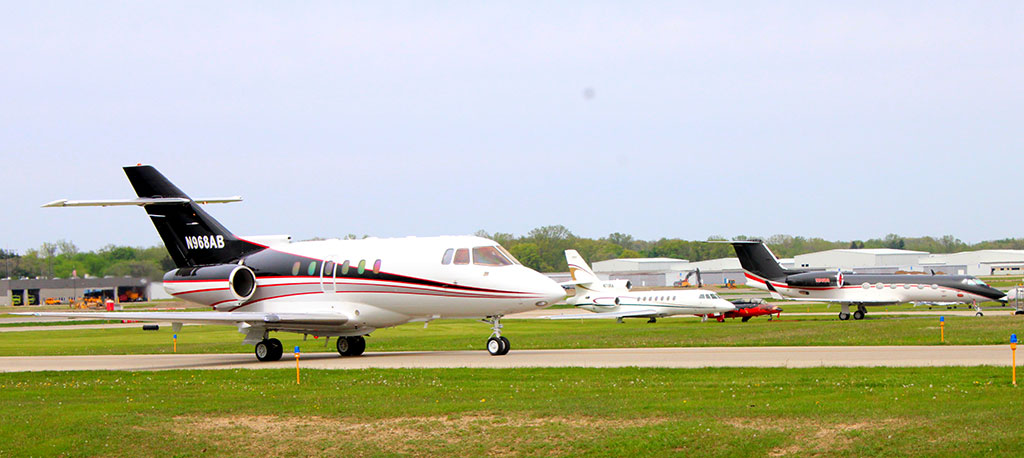
Oscoda Wurtsmith Airport Monday 15th May – A Boeing 747 Classic paradise
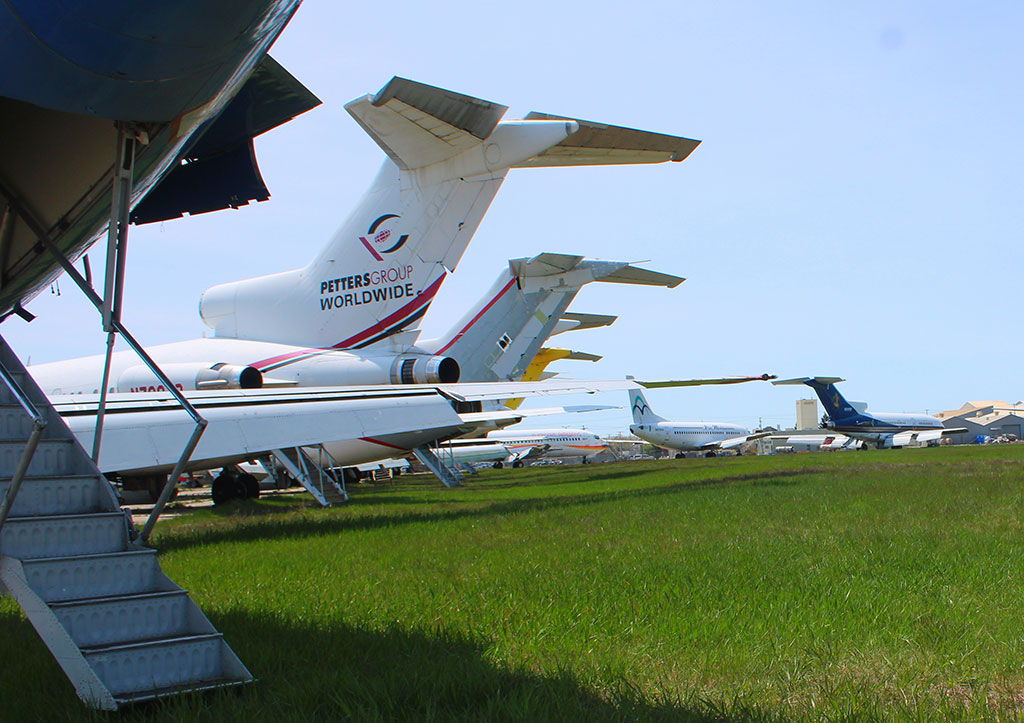
After a splendid Sunday evening spent at Madden’s Bar in Detroit (it really does exist), we set off next morning for Oscoda Wurtsmith airport, a 3 hours’ drive north of Detroit. I had not previously visited this airport but the prospect of seeing a Boeing 727-91, an aircraft type still on the challenge list was too tempting despite adding an extra hundred extra miles to the itinerary. An additional spotting bonus would be resident cargo airline Kalitta Air with its generous collection of stored aircraft that it uses as a source of parts not only for the Company but for other airlines who operate Classic Boeing and McDonald Douglas aircraft types such as the Boeing 747 and the McDonald Douglas MD-11.
The red coloured tail seen in the Kalitta Air Boeing 727-200 and Boeing 737-500 combo photo belongs to former Qantas Boeing 747 VH-OEJ. This aircraft hit the news channels when purchased by Kalitta Air in 2022 and flown out of the Mojave Desert to Oscoda Airport ending any hope that this aircraft may return to Australia for preservation. I have decided not to include a photograph of the aircraft as it is most evident that it will never fly again and would prove too distressing for those readers living “down under”. The airport was home today to 10 retired Boeing 747s, including 2 model 200 variants. From an in-service point of view, 2 “pure” Kalitta Air Classic Boeing 747 400F freighters were parked on the ramp.
The long line of retired wide-bodied jetliners also included Douglas DC10-30 N621AX (formerly N226NW) parked next to McDonald Douglas MD11 N630SN formerly D-ALCS of Lufhansa. The airport has no less than 9 Boeing 727 aircraft in storage, 2 of which were of the short fuselage model. In addition to the retired Boeing 727s, Kalitta Air had 2 in-service Boeing 727-200 aircraft on the ramp being readied for operational duties, as were the Boeing 747 400F aircraft.
Having spent several hours feasting our eyes on such a fabulous collection of Classic Boeing and McDonald Douglas Classic jetliners, we retired to a local sports bar for a late lunch and watched Leicester City versus Liverpool live on TV, much to the amusement of the locals who had come along to enjoy a quiet drink.
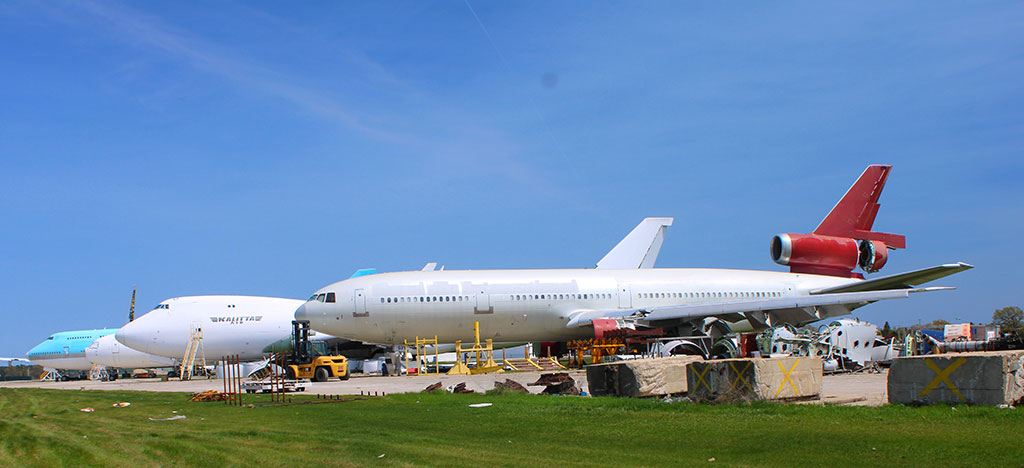
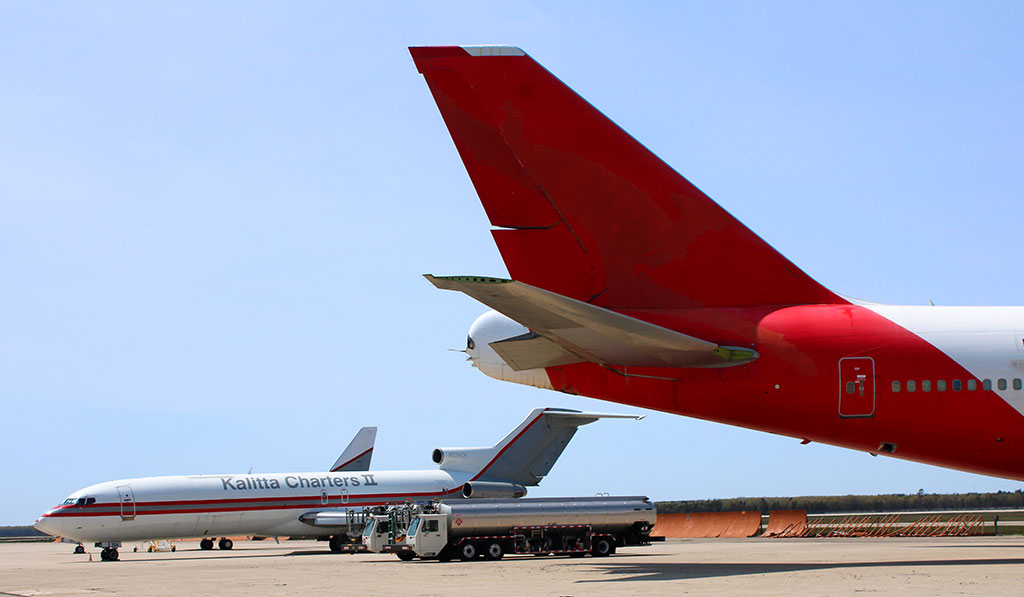
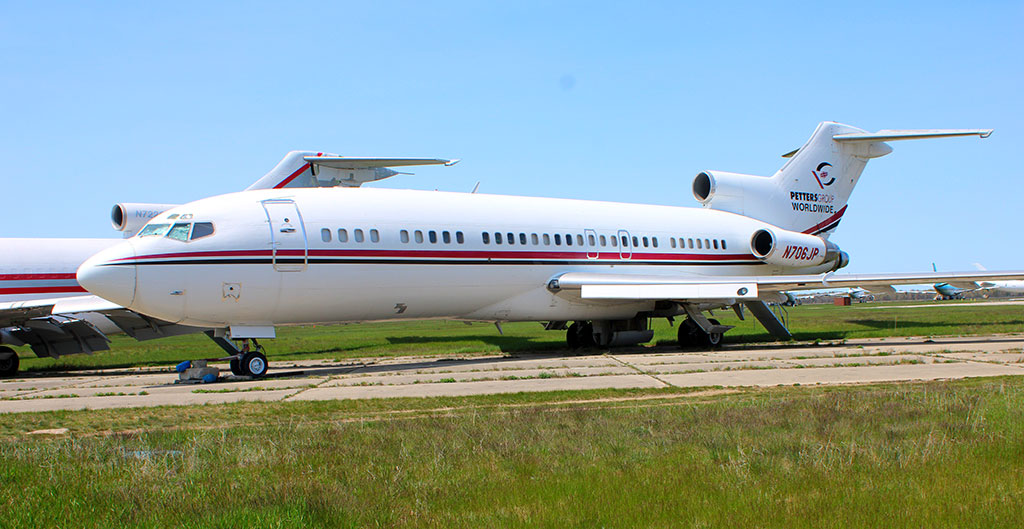
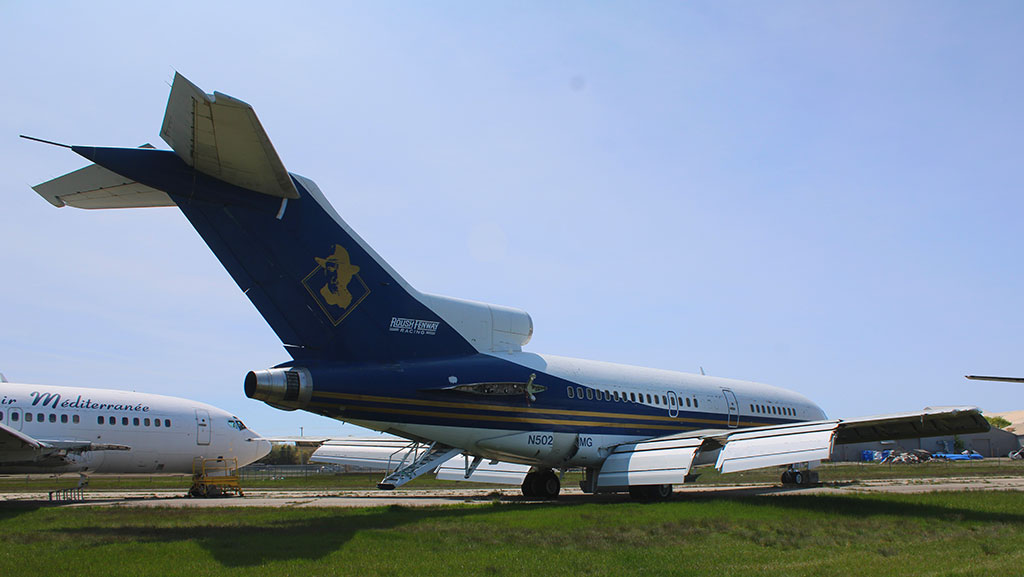
Sault St. Marie Tuesday 16th May – not an Airbus or Boeing aircraft in sight
Crossing the border back into Canada and the itinerary includes the city of Sault St. Marie with a municipal airport close to Lake Superior and the Canadian Bush Plane Museum striding the edge of the St Mary’s River in the heart of the city.
Our first reaction to Sault St. Marie airport is that it feels vastly different to the airports visited on the trip thus far. Firstly, no jetliners in sight but most significantly, an abundance of piston powered general aviation aircraft of all shapes, size and age. It is clear that we have now entered the land of the “bush plane”, where many of the type ply their wares as utility transports serving remote communities often without prepared airstrips.
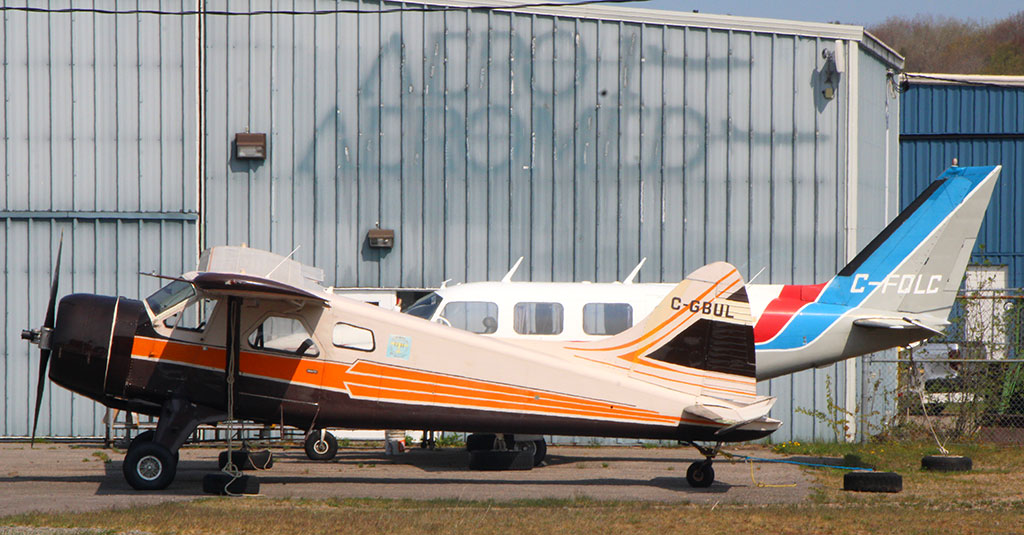
The other spotting attraction afforded at Sault St. Marie airport was the sizeable collection of DHC-8 Q400 aircraft spread out across the airport, including 5 Westjet examples and two former Alaskan aircraft. As with other locations on this trip, there were several older DHC-8 variants scattered around the airport completely devoid of markings and clearly destined not to return to service. The airport also has a considerable population of Zlin Z-242 aircraft operated by the resident Training School and a nice addition to the log book.
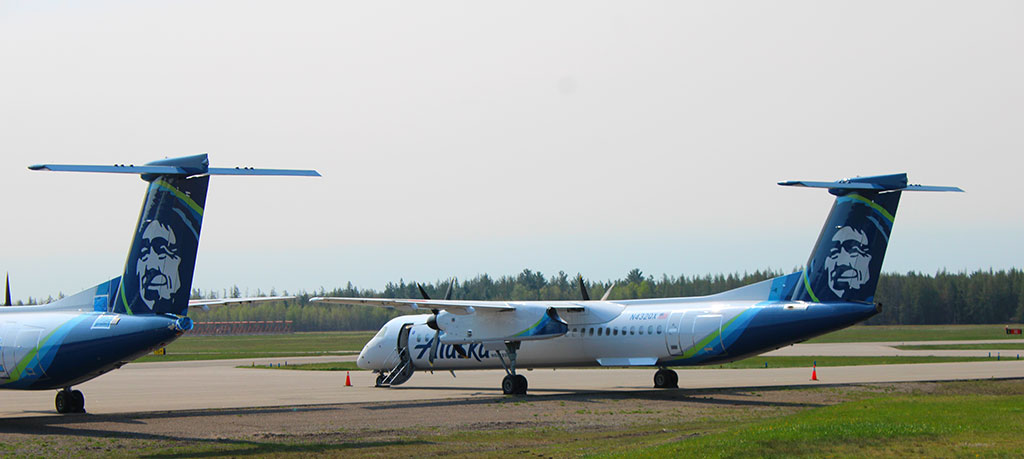
Our next spotting destination necessitated a quick dash into downtown Sault St. Marie and to the Canadian Bush Plane Heritage Centre. Located on the north bank of St. Mary’s River adjacent to the city’s float plane pier, the Museum is dedicated to preserving the history of Canadian bush plane and aerial firefighting aircraft. The Museum’s 30 plus aircraft exhibits are all in magnificent condition, and one has access to the interior of many of the larger types including the Canadair CL-215, float-plane equipped Otter and the Saunders ST-27. The latter aircraft is the sole surviving example of the type and along with the Fairchild Huskey, was one of the main reasons for including the Museum on this trip.
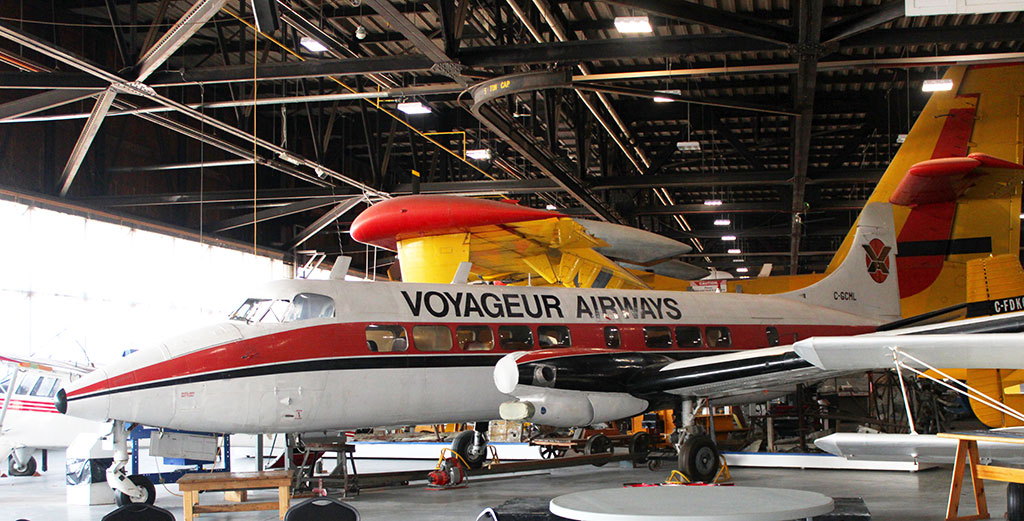
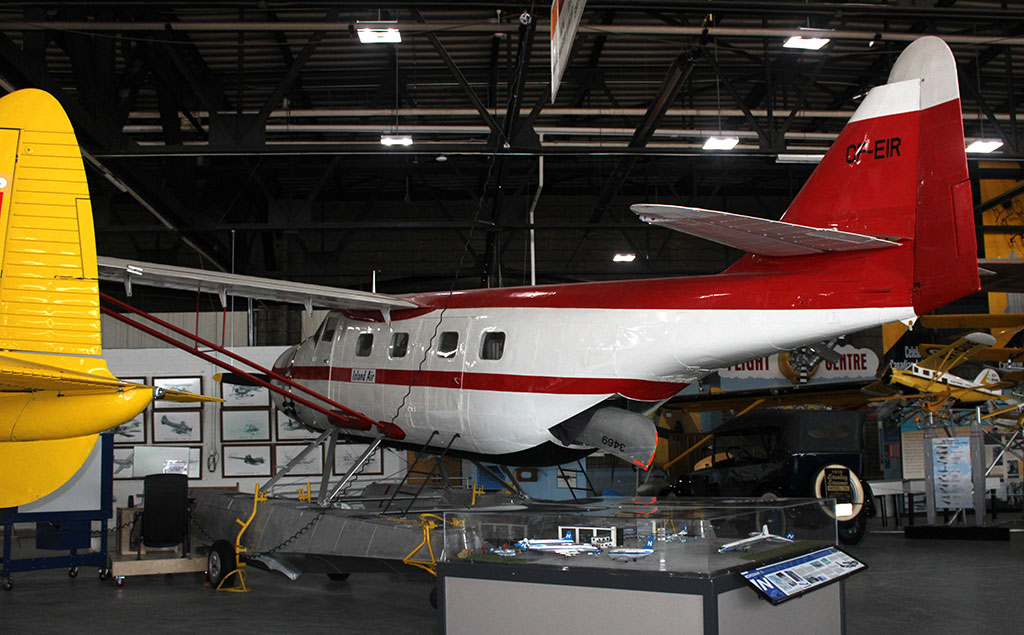
I had spotted a number of ST-27 aircraft belonging to Voyageur during previous visits to Toronto Island Airport in the late 1970s, but I had never boarded one before. What struck me today when seated aboard the museum exhibit was just how dated the aircraft felt for an airliner manufactured in the 1970s. The penny soon dropped as to why this was the case; the ST-27 was manufactured using several DH Heron fuselages, a type which in fact was based on the DH Dove which first flew in 1945. It was a real privilege to sit on board the sole surviving ST-27 and imagine what it must have been like to commute in and out of downtown Toronto to places in Northern Ontario such as Sault St. Marie.
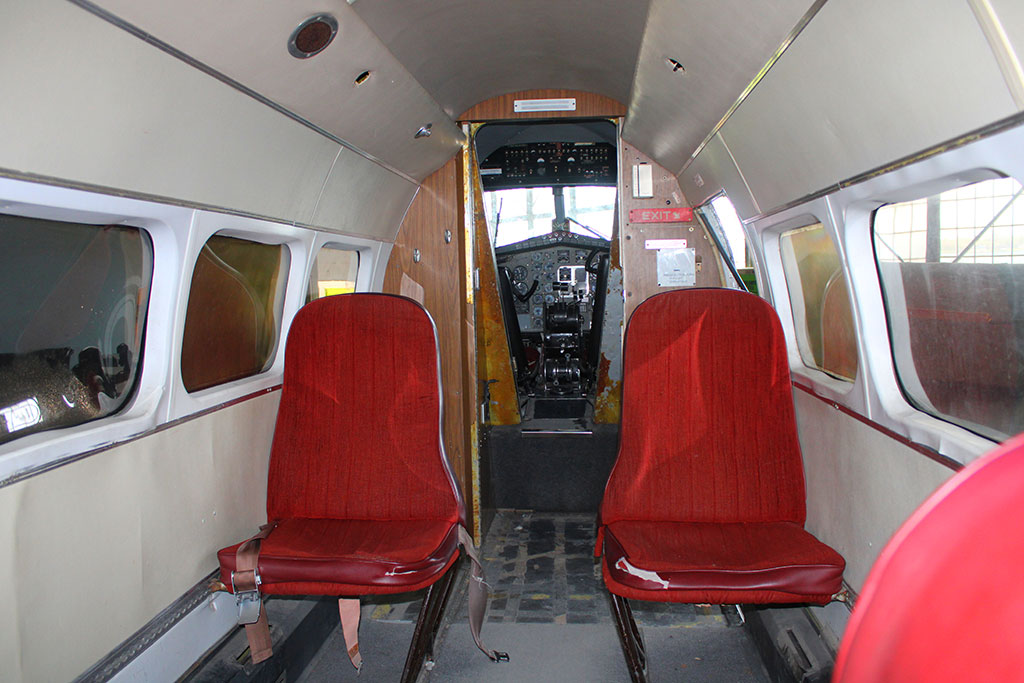
Many of the Museum’s exhibits are still kitted out in their original role as aerial firefighters. For example, the floats fitted to the DHC-2 Beaver still sport the original water tanks that were used for firefighting duties. I was informed that the tanks were filled by hand after landing on water, then opened by hand in flight using wire cables running from the tanks to the flight deck! Before conversion into a firefighter, the Museum’s Grumman Tracker performed ASW duties aboard HMSC Bonaventure, Canada’s last active Aircraft Carrier before decommission in 1971.
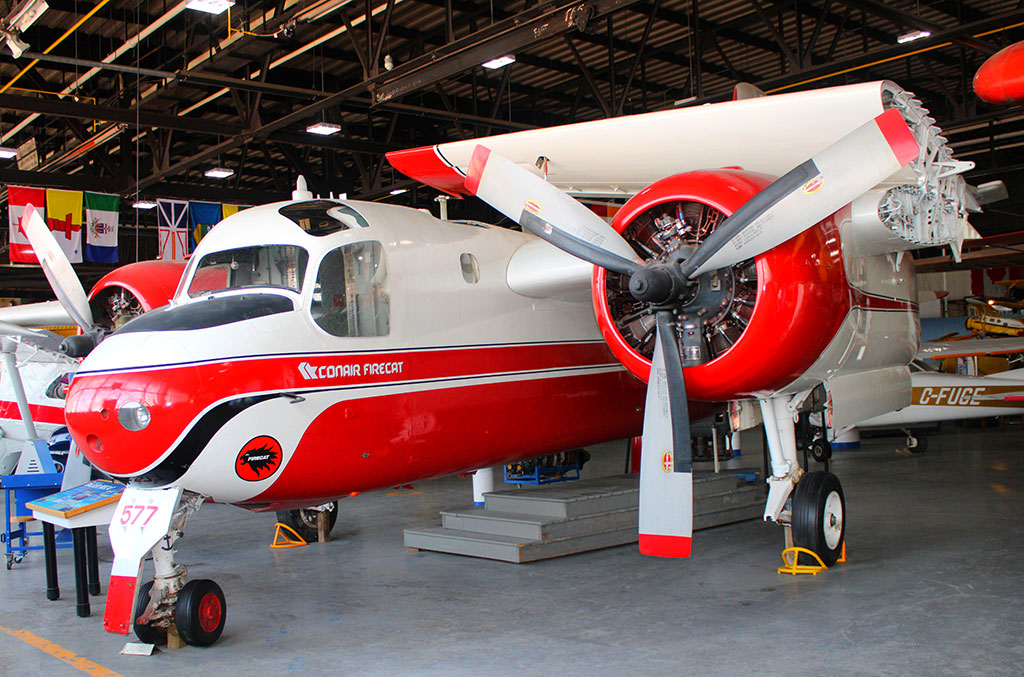
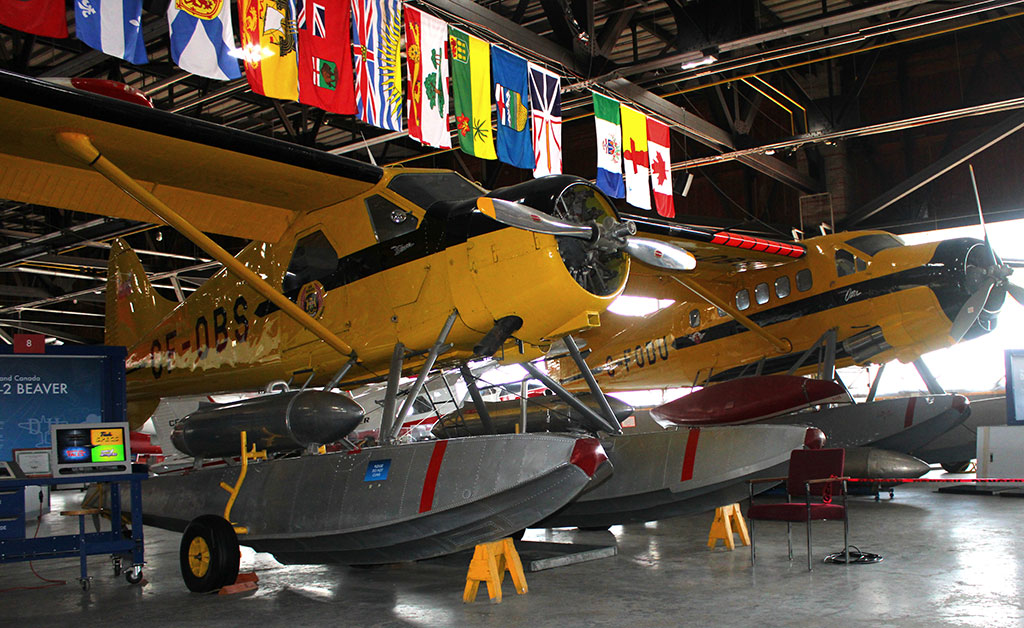
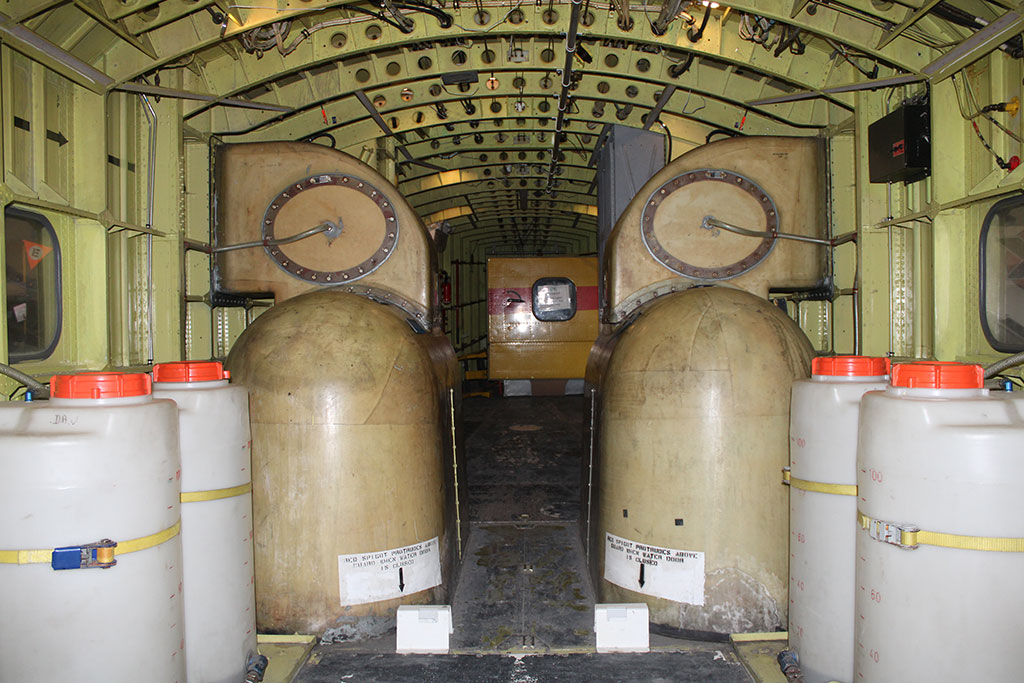
I had never spotted a Fairchild F-11 Huskey before, and what an interesting aircraft it is, a small civilian utility aircraft complete with rear clam shell doors (note canoe in photograph). The aircraft was developed to compete with the DHC Beaver/ Otter designs, but failed to gain commercial success and only 12 examples were manufactured with C-FBFT being one of only 2 surviving aircraft. The museum also has an immaculate Republic Seabee, the sole example seen on our trip and what a delight it was too.
Our third spotting venue of the day was Bar River Airport, a private facility operated by Springer Aviation who provide numerous services to the aviation industry including aircraft modifications, maintenance, painting, and floatplane conversion. The airport boasts not only 2 runways, but also a purpose-built canal for use by float plane equipped aircraft. Located 45 minutes’ drive from Sault St. Marie and just 5 minutes off the Trans-Canada Highway, the airport was too tempting to ignore, or should I say it was the 3 resident HS 748 aircraft that lured us there.
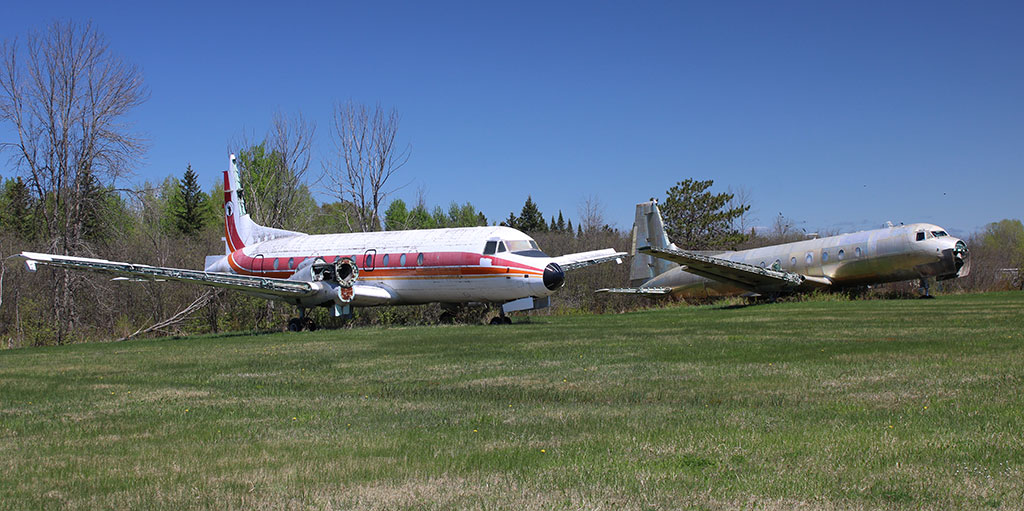
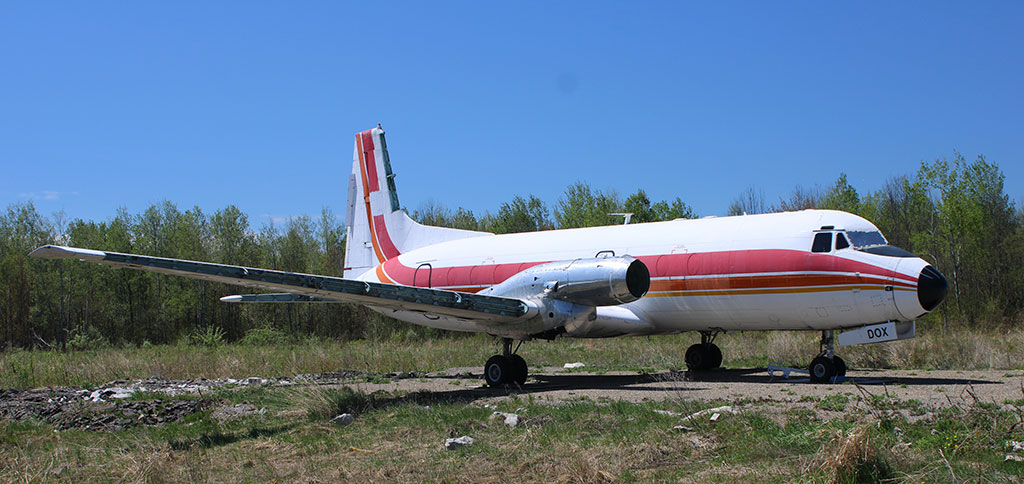
The three former Air Inuit aircraft are in various states of “retirement”, with cargo door equipped C-FDOT being the most complete and missing only a few obvious parts. Only C-FKTL flew in the UK during the 1970s/80s, and as G-BEXG many of you may well have spotted or even flown on her whilst in service with Dan Air. The aircraft was taken by road to Bar River in 1999 after a fire at Great Trout Lake airport rendered her beyond repair. C-FGET flew from new with the German National Flight Calibration unit until 1989, after which being sold for airline use in Canada. It was particularly pleasing to see several examples of a type that has been a successful servant to numerous Canadian airlines over the last 5 decades. Today’s visit reminded me of my first flight on board a HS748, G-BEKG of British Independent Airways in 1990, all 15 minutes each way for the 43-mile flight between Lydd and Le Touquet.
Dan Springer has been involved in aviation for over half a century and very much welcomes enthusiasts to his airport. The facility performs maintenance work on Canada’s surviving operational HS 748 fleet, one of which had recently been in the workshop and departed North only a matter of weeks before our visit. The current Google Maps Street View image from the road adjacent to the airport shows LIAT ATR 72-600 V2-LIC visiting the facility. I flew on this aircraft from Barbados to St. Vincent in June 2019, and then spotted it out of service during a visit to Antigua in December 2021 (Read the Trip Report). The aircraft passed through the Springer Aerospace workshop before delivery to Voepass Airlines of Puerto Rico at the end of 2022.
Our final destination of the day was “Nickel Town”, or correctly named Sudbury. The city takes its nick name from the meteorite that hit the locality almost 2 billion years ago and gifted the planet (and later Canada) with a generous deposit of Nickel ore. The airport is home to a number of interesting airlines that serve not just the local Nickel smelting industry, but other gold and copper mining communities located north of Sudbury. In addition, several operators have aircraft based on site in support of medevac and aerial firefighting duties. We planned the timing of our visit not just to spot the many interesting resident aircraft, but to also coincide with the evening services operated by Propair and Bearskin Airlines to the remote communities of Rouyn and North Bay respectively.
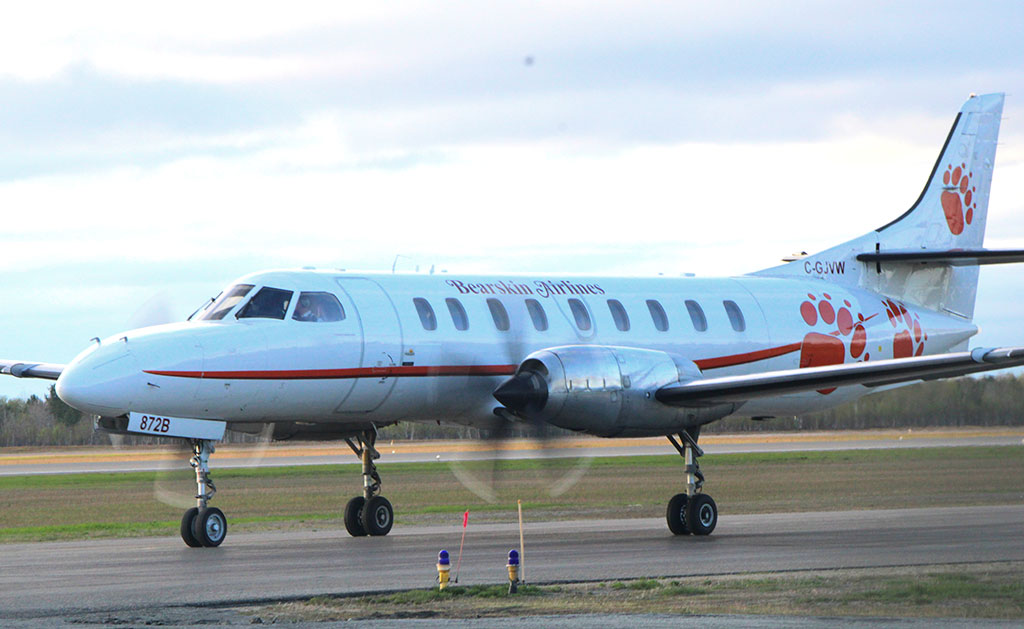
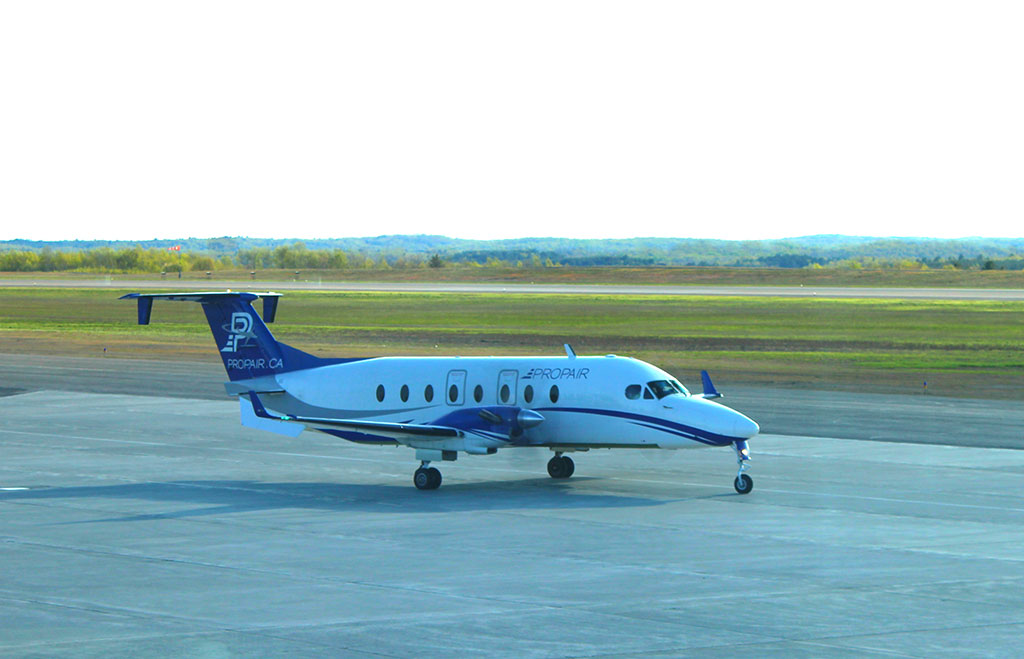
Our brief spotting visit provided an array of interesting aircraft including Thunder Air Mitsubishi MU-2 C-FRWK and no less than 3 active Rockwell Commanders belonging to MAG aviation, all of which are used alongside their Cessna Skymaster fleet on fire spotting duties. The weather may look favourable in the photographs, but the temperature dropped quickly after our arrival at the airport as the Artic wind swept in from the North and we awoke next morning to a temperature of -2C and a layer of frost on our hire car.

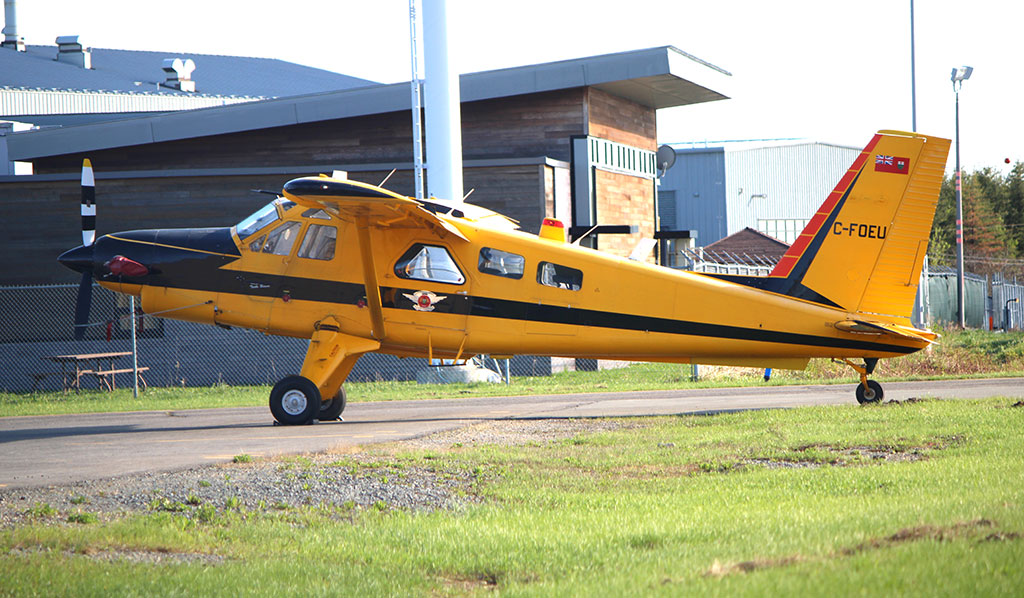
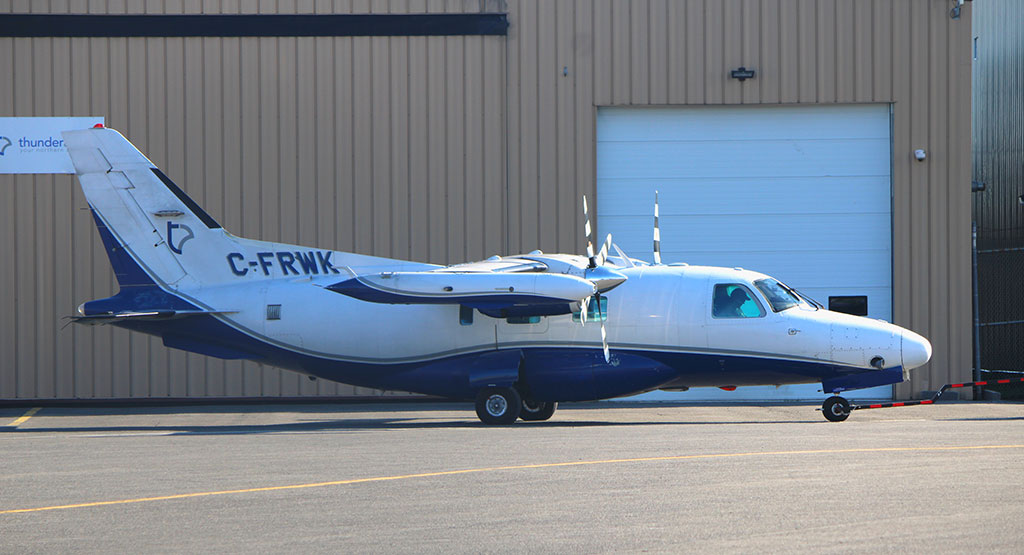
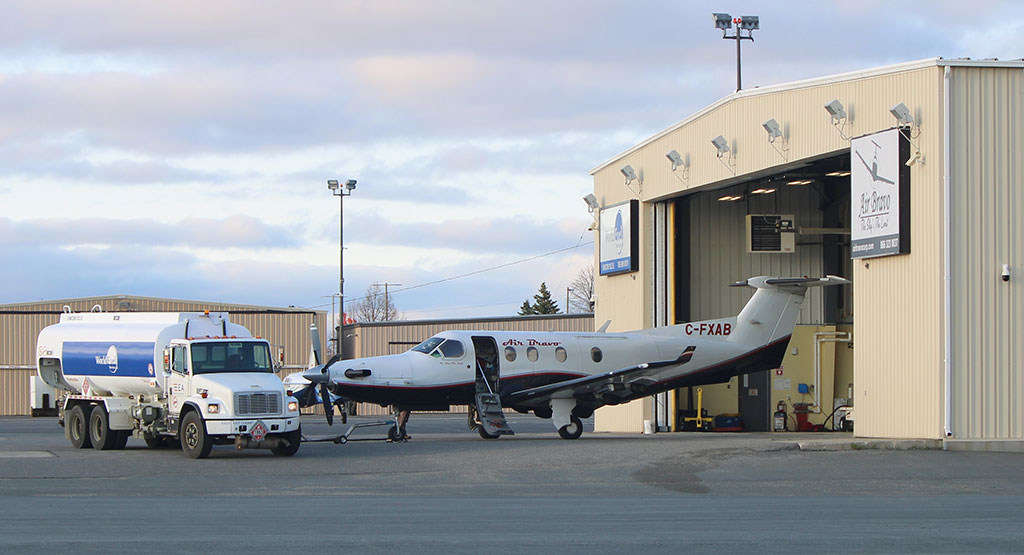
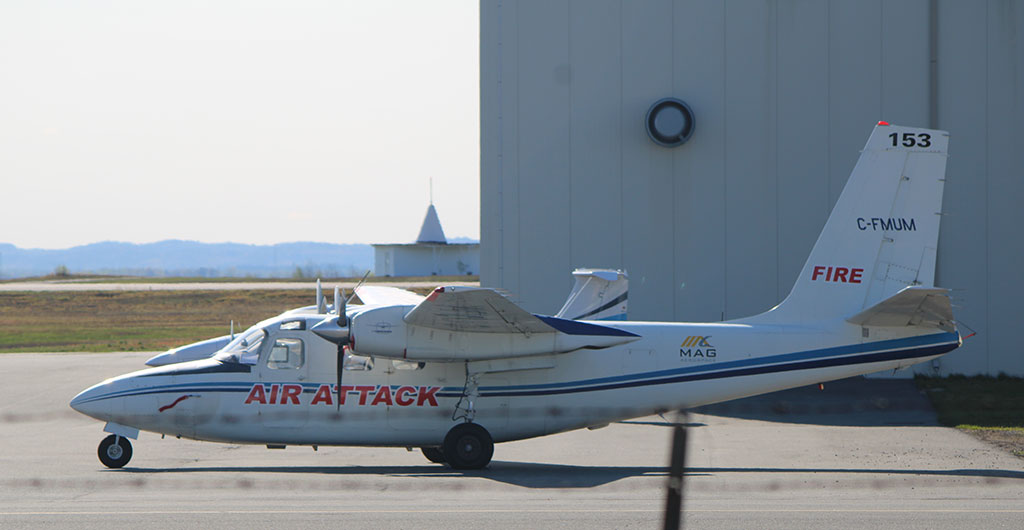
Muskoka Airport Wednesday 17th May – Have we met Before?
After a 3 hour drive due South from Sudbury, we stopped for a rest break at Parry Sound Municipal airport. Not wanting to be accused of throwing the “Beaver amongst the pigeons”, but during our hot beverage stop we discovered that possibly Canada’s finest looking piston powered DHC-2 was on the ground at Muskoka airport just an hour’s drive away. Excellent news, as Muskoka was on our itinerary and where we expected to spot Ken Borek DC3-T “Polar 5” that was in town for inspection work on its geological sensing equipment. What we didn’t know before hand is that the airport is also home to a number of stored ATR and DHC passenger aircraft.
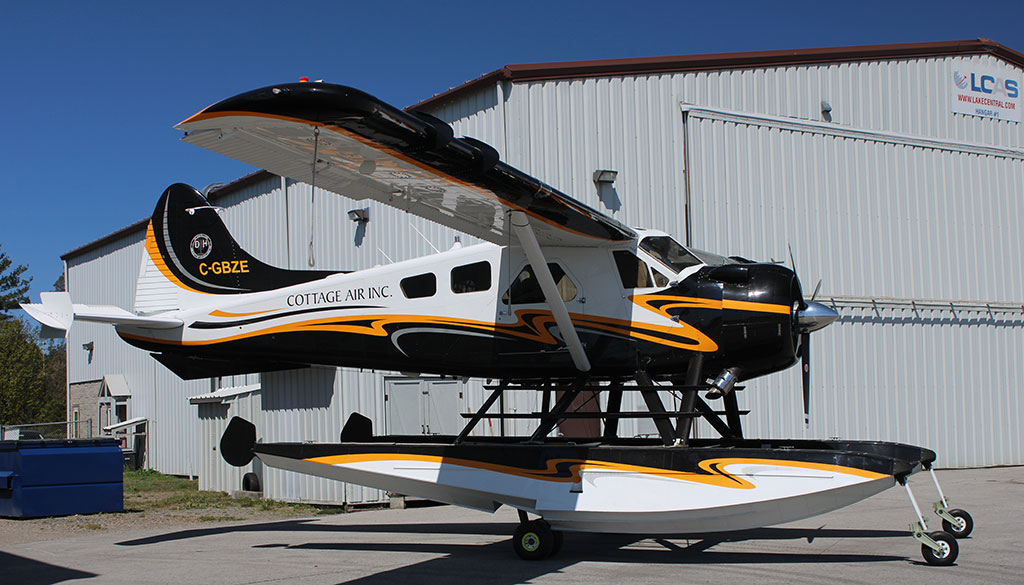
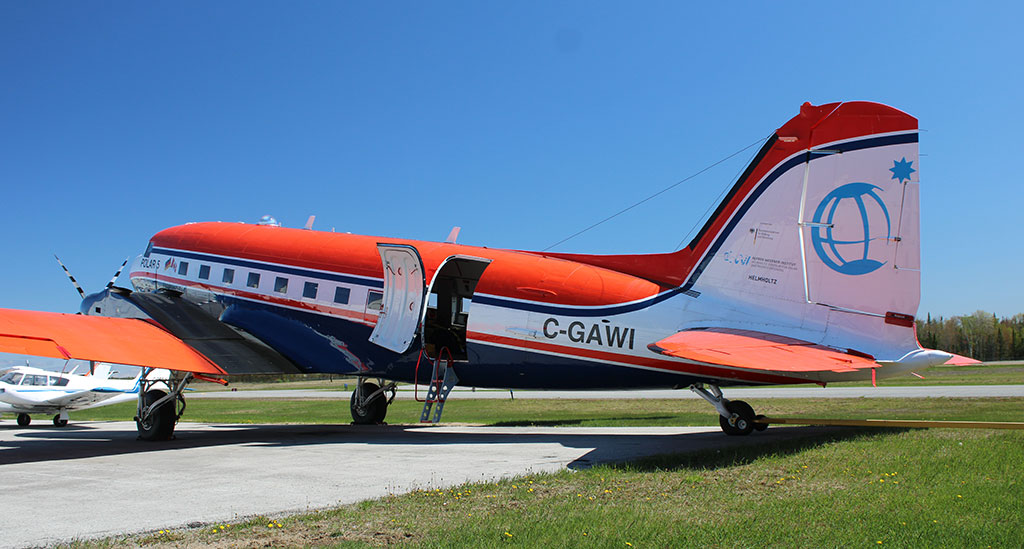
Having spent some time in the presence of two such pristine examples of their kind, we moved on to the main airport building which is appropriately located at number 1011 Airport Road.
The ramp was host to 4 Liat ATR 72-600s, 2 FlyBe DHC-8 Q400s, Connect DHC-8 Q400 and two DHC-8 aircraft completely void of markings. Interesting spotting fodder for sure, but what unfolded as I checked the various aircraft histories was that I had indeed been in the presence of 7 out of the 9 aircraft and actually flown on one of them. As it transpires, I had flown on one of the FlyBe aircraft from Heathrow to Edinburgh, spotted the Connect aircraft flying for Olympic Airways whilst on holiday in Skiathos, and spotted all 4 Liat ATRs sitting out of service in Antigua. Both FlyBe aircraft have been acquired by Conair, and these aircraft should have a long and illustrious new career ahead of them as aerial fire fighters. Connect is due to commence operations later this summer and DHC-8 Q400 N885WM is currently being used on route proving flights from Billy Bishop airport in downtown Toronto to various US destinations.
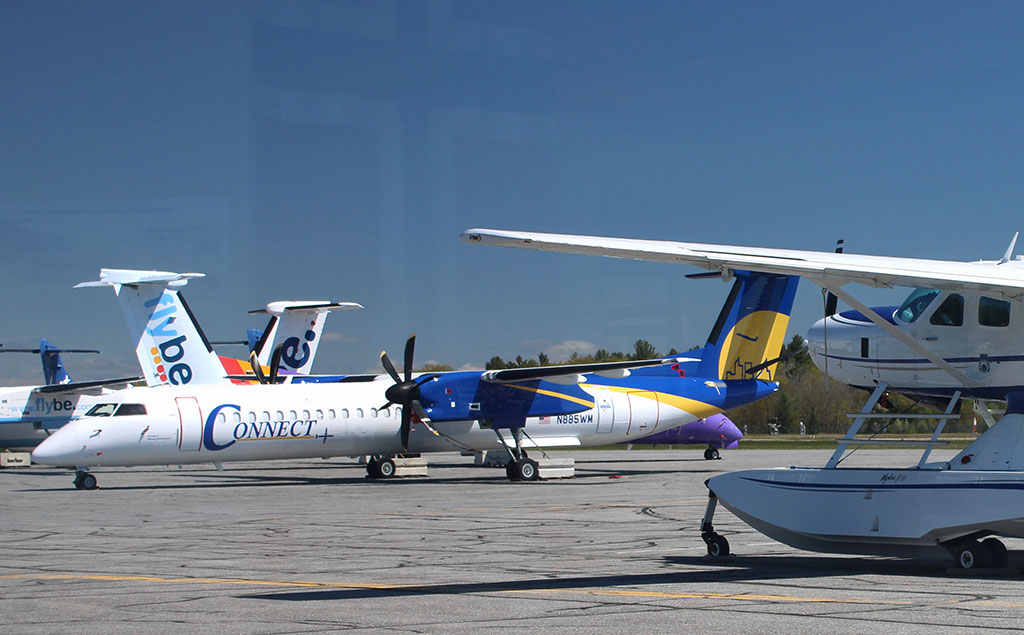
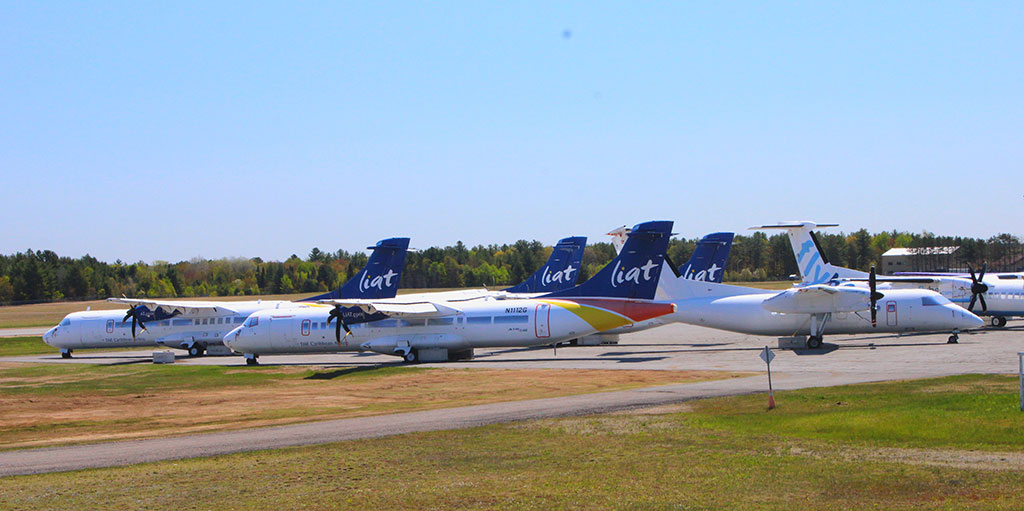
Oshawa Executive Airport
Having left the Artic winds and blighted landscape of Sudbury behind us, a further 90 minutes’ drive south from the truly beautiful Muskoka region delivered us to Oshawa Executive airport and the balmy heat of Southern Ontario. Air Nunavut is based at Oshawa and I was confident of seeing several of their Falcon 20s and of great interest to me, their Falcon 10. The airport also provided our second DC3-T of the day C-GEAG, and surprisingly our second Antonov of the trip, AN-2 C-GFBR. It was truly rewarding to see two DC3-T aircraft in a single day, an aircraft not indigenous but certainly synonymous with Canada and its vast wilderness. My trip buddy confesses that the two DC3-T aircraft were his favourite sightings of the trip, a judgement difficult to dispute. Incidentally, Falcon 20 C-GZYX seen in the photograph below visited Leeds Bradford airport on June 11th, having flown in from Oshawa via Shannon.
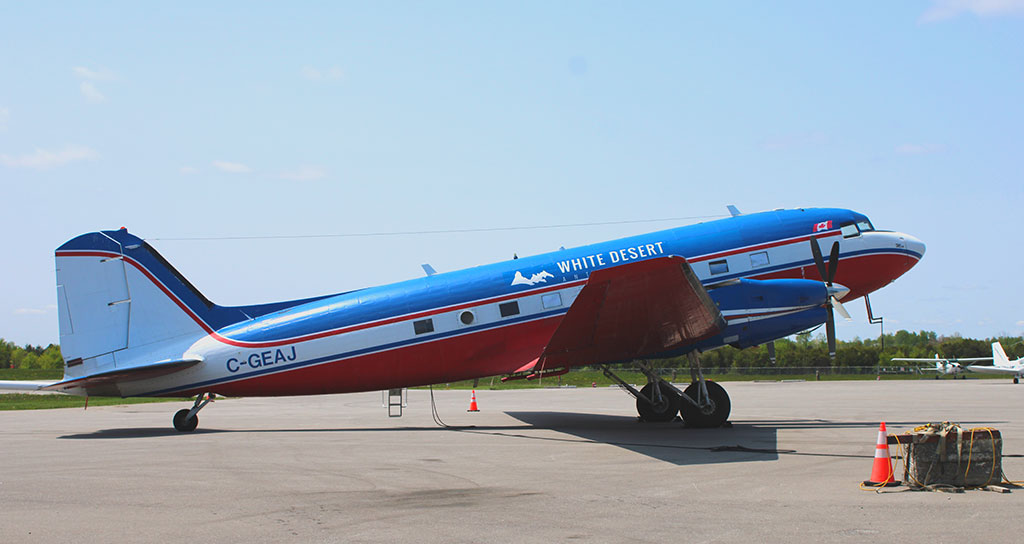
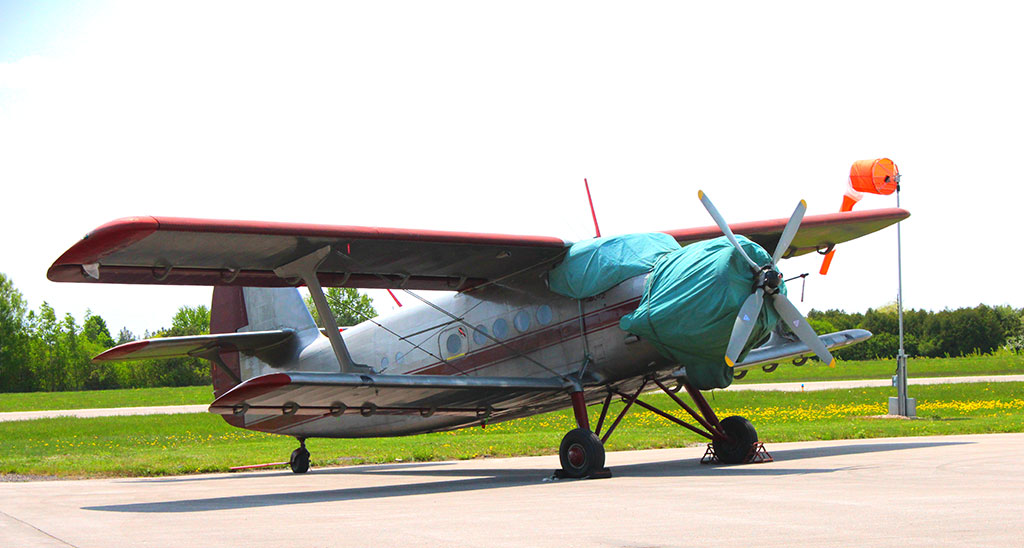
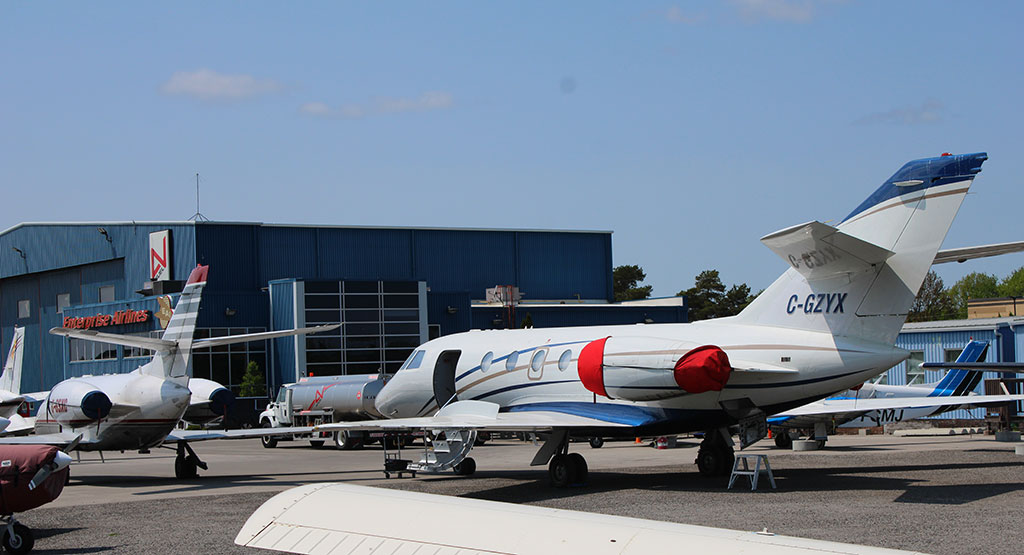
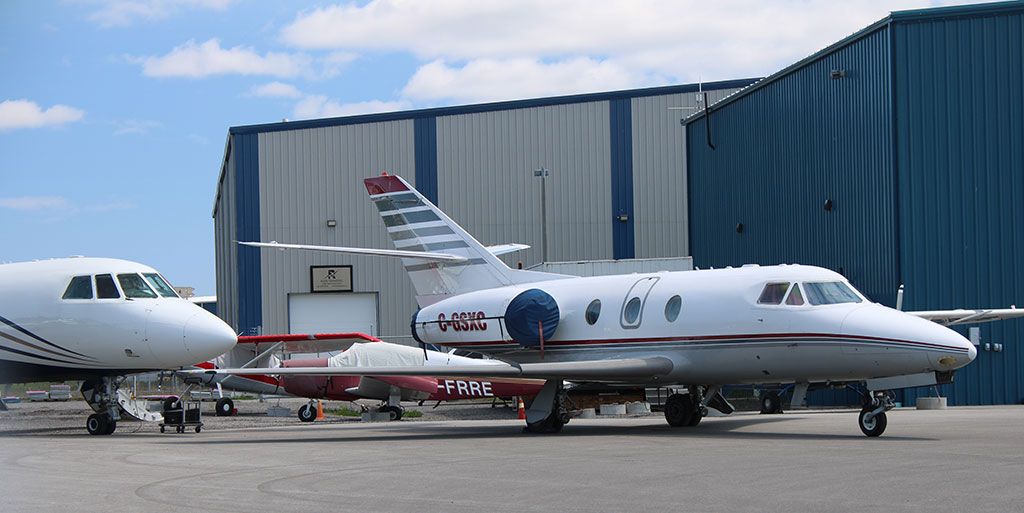
Trenton
Today had always been planned as the most intense from a driving perspective, and we still had to visit the National Air Force Museum in Trenton and then onto Ottawa’s airport before rewarding ourselves with a gastro burger and a craft brewery trail in downtown Ottawa that evening.
Our 4-hour journey from Oshawa to Ottawa included a 15-minute stop at the National Air Force Museum of Canada to spot their very rare Boeing 720. Previously owned by American Airlines and latterly MEA, this aircraft last flew as an experimental Flight Test Bed with Pratt & Whitney Canada based in Montreal. Our visit also revealed several of the last remaining operational RCAF DHC-5 Buffalos parked on the ramp at the adjacent RCAF Trenton airbase, along with RCAF CC-150 Polaris. The very same “A310” was spotted the following day departing Ottawa airport as we parked up at the Canada Aviation & Space Museum in Ottawa. Not wanting to appear morbid, but I suspect this may well be the last time I witness an A310 in flight and so close up?
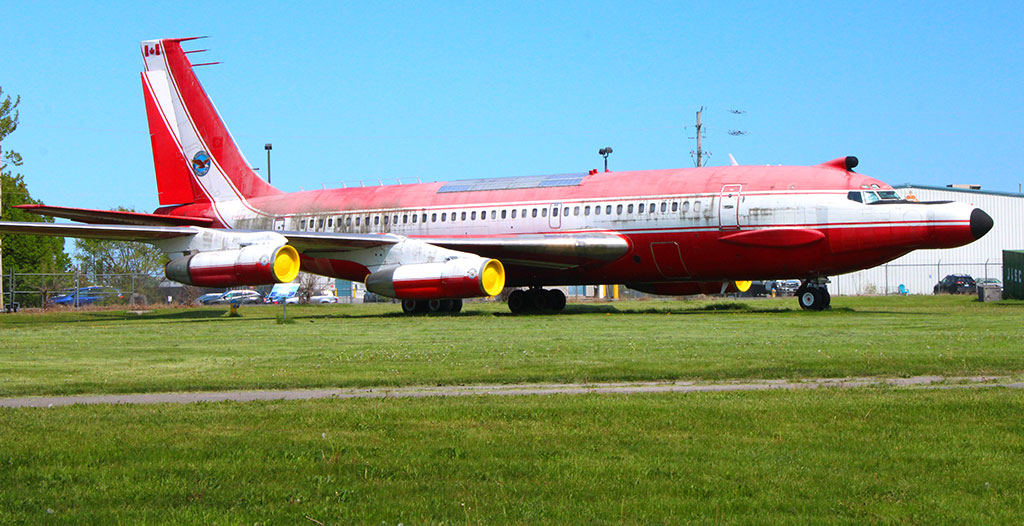
After a total of 10 hours driving and 508 miles since departing Sudbury that morning, we arrived somewhat exhausted at Ottawa airport. Not a lot to report, except we had clearly left the land of the bush plane behind us and arrived back into the domain of the modern jetliner. Of note though was the retired B737-200 of the Canadian National Research Centre, unfortunately the airport access roads at this point did not allow us to park and we were unable take a photograph of the aircraft.
Ottawa & Montreal Thursday 18th May – Bienvenue
The raison d’etra for traveling east is that the 4 locations to be visited in the next 36 hours provided the potential to remove more than 10 aircraft from the challenge list, including the much-prized Pratt & Whitney Canada owned Boeing 747-SP based at Montreal Mirabel airport. I was also looking forward to seeing several airliner types that I had not seen before, including the Rolls Royce Merlin powered Canadian North Star and the Avro Canada C102 Jetliner. The 3 Montreal airports are also home to Air Inuit, Nolanair, Glencore and Chrono Aviation, who between them operate Canada’s remaining Boeing 737-200 fleet serving remote mining and native Indian communities throughout the Province of Quebec.
The DH Comet beat the Avro Canada C102 to the air by just 13 days leaving the Canadian jetliner with the title of second jet liner to fly. By all accounts a promising aircraft, only for the programme to be terminated by the Canadian Government in favour of development of the CF-100 Canuck jet fighter. Howard Hughes “borrowed” the aircraft for a while in an effort to secure industrial backing to build the type in the USA, but Cold War jitters meant funds for the development of commercial aircraft were in short supply and jet fighters were the order of the day. I am curious to know if Howard Hughes’ personal use of the Avro Canada C102 qualifies this aircraft as being the world’s first biz-jet?
A couple of house rules to be aware of before visiting the Canadian Space Museum in Ottawa. Firstly, the main exhibition hall it is not open on Monday and Tuesday, and it is advisable to book entrance tickets in advance so as to guarantee admission at your desired time. The second exhibition hall is named the “reserve hangar”, cannot be booked in advance, and admits only a limited number of people per day/ per guided tour. We arrived at the Museum early that morning to ensure that our names would be the first to be added to one of the guided tours available that day. Thankfully our plan worked and we were two of 15 people on the first guided tour of the day at 11:30am.
Both the Exhibition Hall and the Reserve Hangar contain some superb aircraft spanning the whole spectrum of aviation types and genres. The main exhibition Hall is spacious and the many aircraft are easily photographed, whereas the “Reserve Hangar” is the complete opposite. The aircraft held in the “Reserve Hangar” have all been shoe-horned into the building in order to protect them from the elements and appear to be engaged in a massive game of Twister. You can gauge what I mean from the photographs below, some of the aircraft taken are only just recognisable amongst the assorted aviation clutter but at the end of the day seeing them for real was so rewarding.
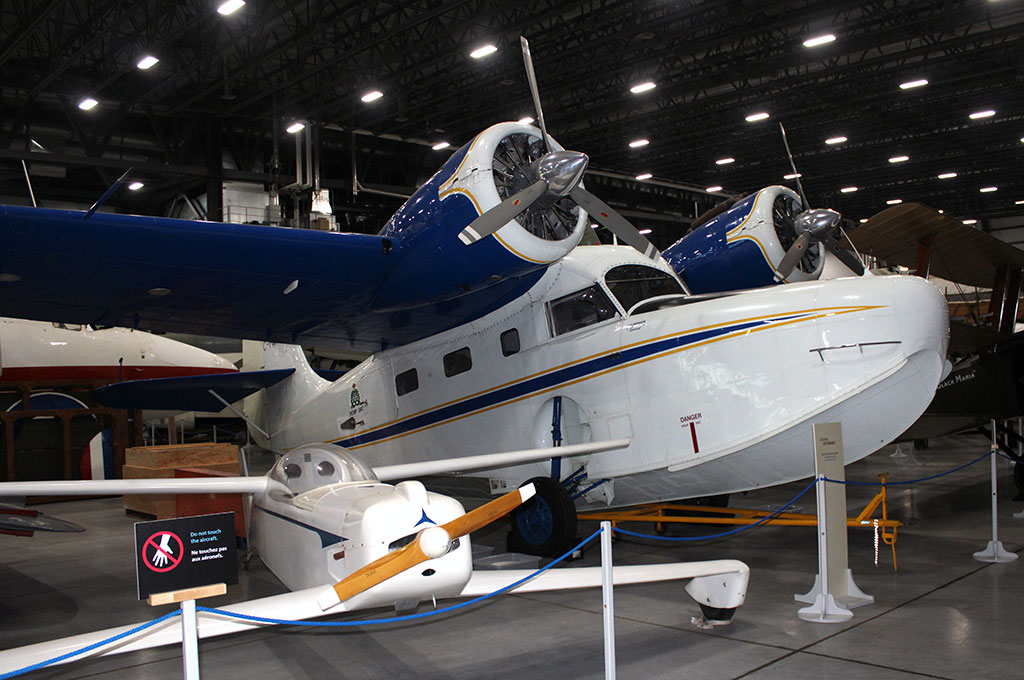
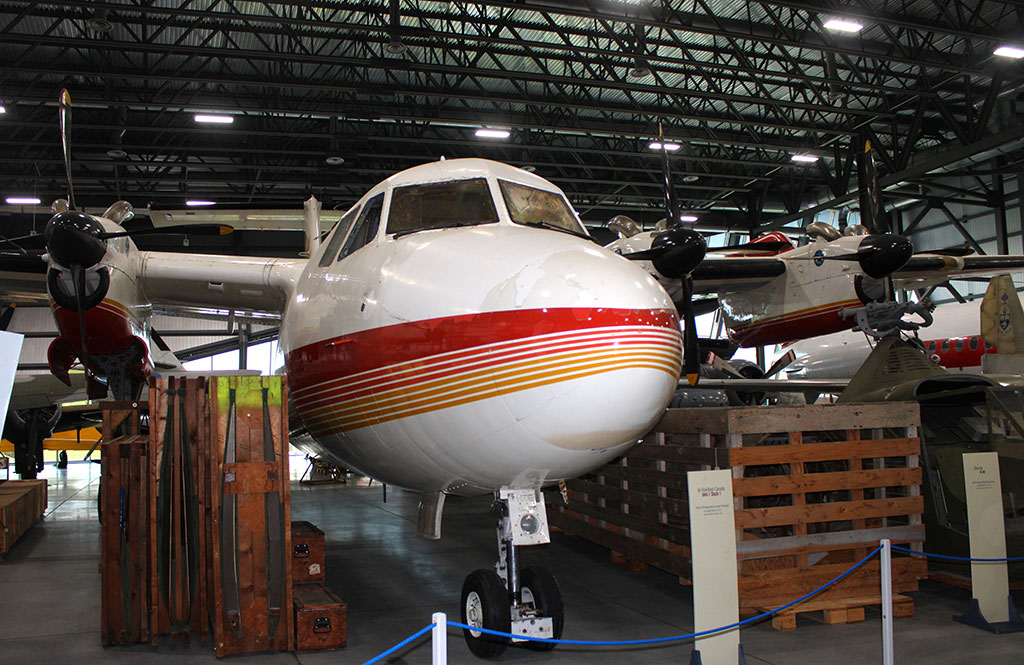
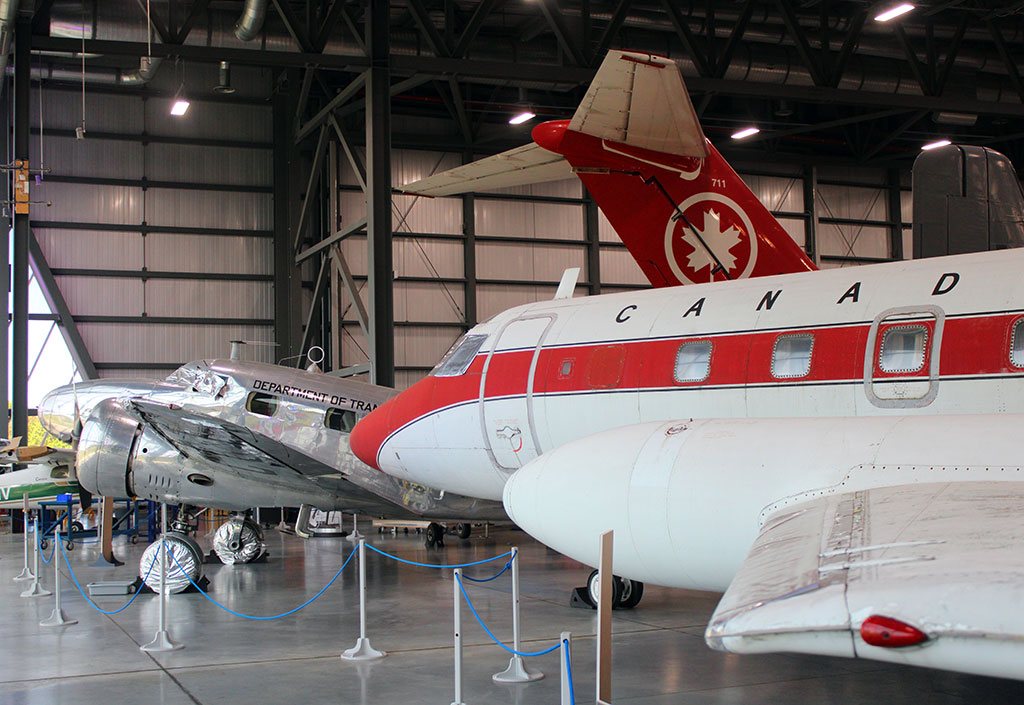
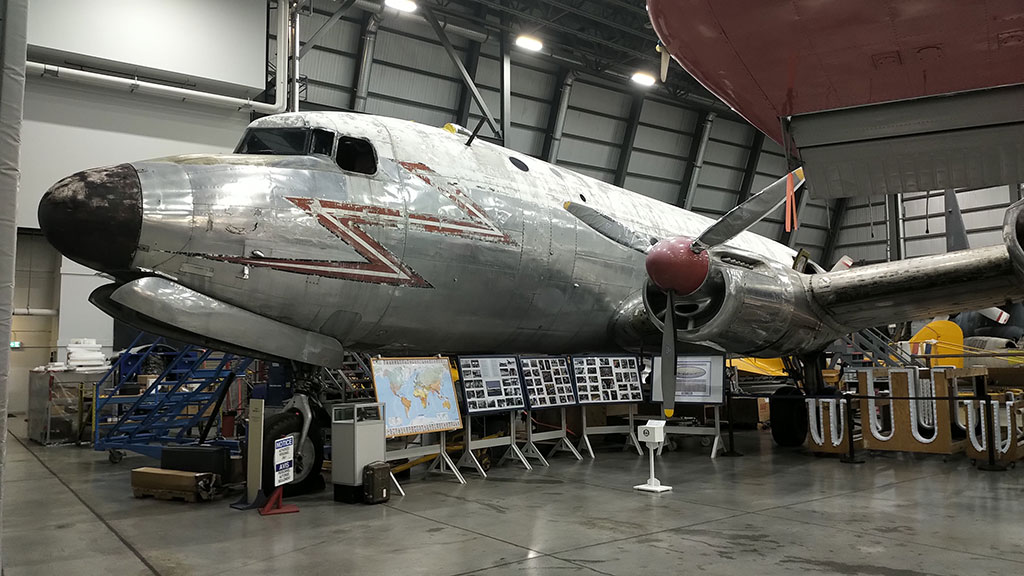
It was good to be reunited with Air Canada Douglas DC9-32 C-FTLL, I last logged this aircraft at Toronto airport in 1984. This particular aircraft not only lays claim to being Air Canada’s longest serving Douglas DC9, but perhaps for performing the most daring landing made by the type anywhere in the world? Having acquired the aircraft, the Museum realised that their runway was much too short for a conventional landing and the authorities were forced to come up with a novel idea to enable the aircraft to land without overrunning the runway.
Not surprisingly, reverse thrust on jetliners is hard wired so not to be activated in flight. You guessed, for this landing it was disabled and at a height of 20 feet above the runway threshold, reverse thrust was activated and the aircraft thankfully came to a halt at the end of the short runway. I am informed that when the aircraft “fell from the sky” the undercarriage took such a battering that it can never again be used to support the aircraft in motion.
Montreal Hubert Airport
The airport may not boast the large carriers associated with the other Montreal airports, but what it lacks in numbers it more than compensates in terms of interesting aircraft types and operators.
Home to Chrono Aviation and their Boeing 737-200 fleet, we spotted C-FYPN for the second time this trip whilst another example was unfortunately locked away out of sight in the Company hanger. Pascan Aviation is also based at the airport and provided 3 out of service Jetstream 31 aircraft along with an operational Jetstream 31 and Saab 340, the latter departed during our visit but excessive heat haze covering the runway prevented any photography.
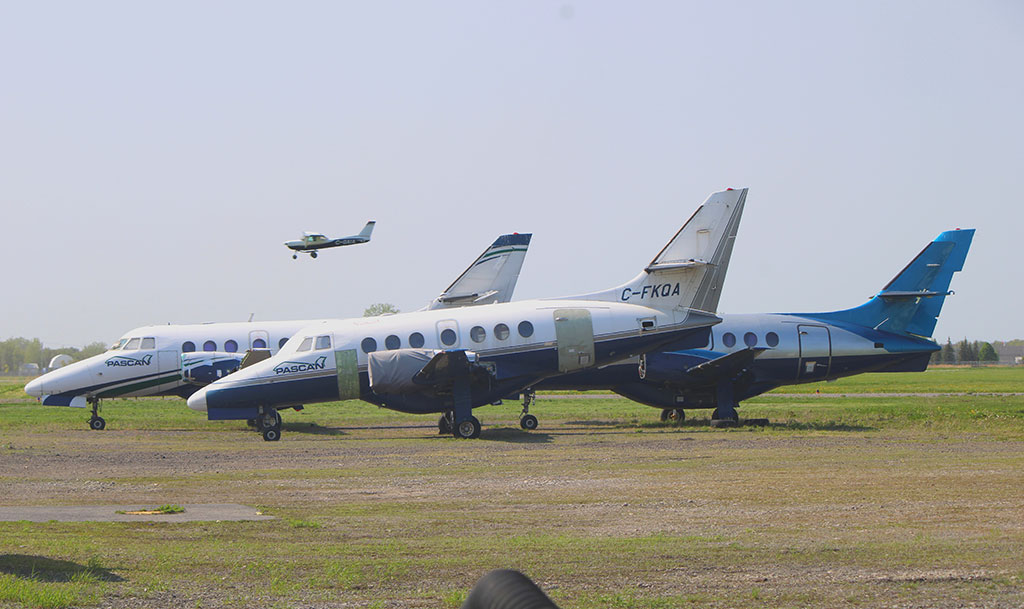
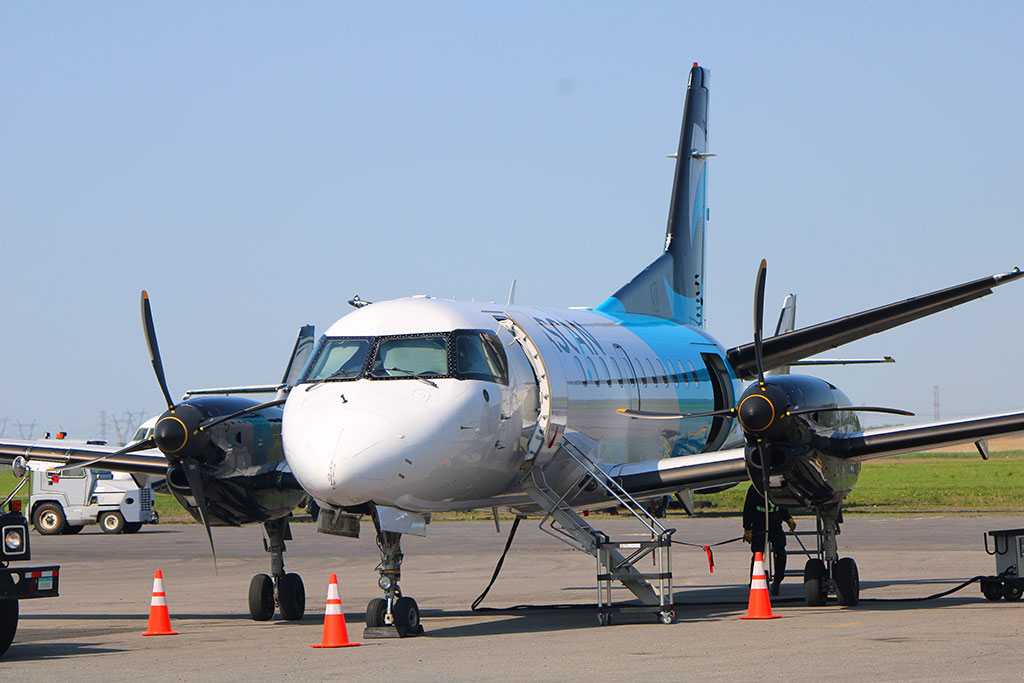
It was nice to be reacquainted with a Jetstream 31, I have only ever flown on one example and that included a certain amount of jeopardy at the time. I was booked on a late Friday evening flight with BASE Regional Airlines from Rotterdam to Manchester in 1996, all perfectly orchestrated on business and likely never to be repeated. At the departure gate the airline announced that the flight was full and that 2 “volunteers” were required not to join the flight due to weight restrictions. A taxi was provided and 2 volunteers were duly taken to Amsterdam for a night in a hotel and a flight with KLM to Manchester the next morning. I thought, at least the flight will depart now and I will be able to add another aircraft type to the list.
On board and all buckled up for departure, the captain declared that the aircraft was still over weight and that we would need to lose yet another passenger. A generous cash payment was offered, but no one volunteered to leave the aircraft. After a few minutes silence the bounty was further raised but still no one accepted. It was at this point that I began to question what I was doing and was it really worth missing out on an all-expenses paid night in Amsterdam plus a generous cash payment just to fly on a new aircraft type? The thought was dangerously swilling around my head when a passenger behind me reneged and took the bait. My allegiance to the hobby was tested that evening and thankfully the third passenger saved me from what could have been an embarrassing admission.
The Max Aviation ramp was a delight, I cannot ever remember seeing so many Beech King Air aircraft parked together all ready for operation. I do hope the photograph captures at least part of the moment I experienced. Since returning home I have been trying to come up with a suitable collective noun for a group of Beech King Airs, my best effort so far is a “Kingdom”. Cringe worthy I know, suggestions welcome.
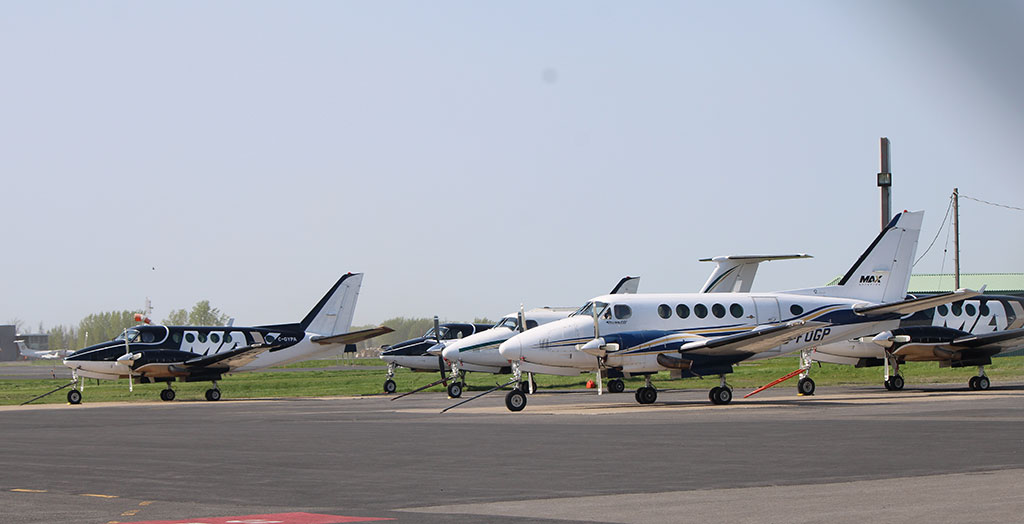
We also spotted turbo powered variants of the PC-6 Porter and DHC-3 Otter, both stunning examples of their kind. Otter C-GLCO is used to transport clients to holiday lodges owned by the parent company Norpaq Aviation, often in remote locations only accessible by such a rugged aircraft as the Otter.
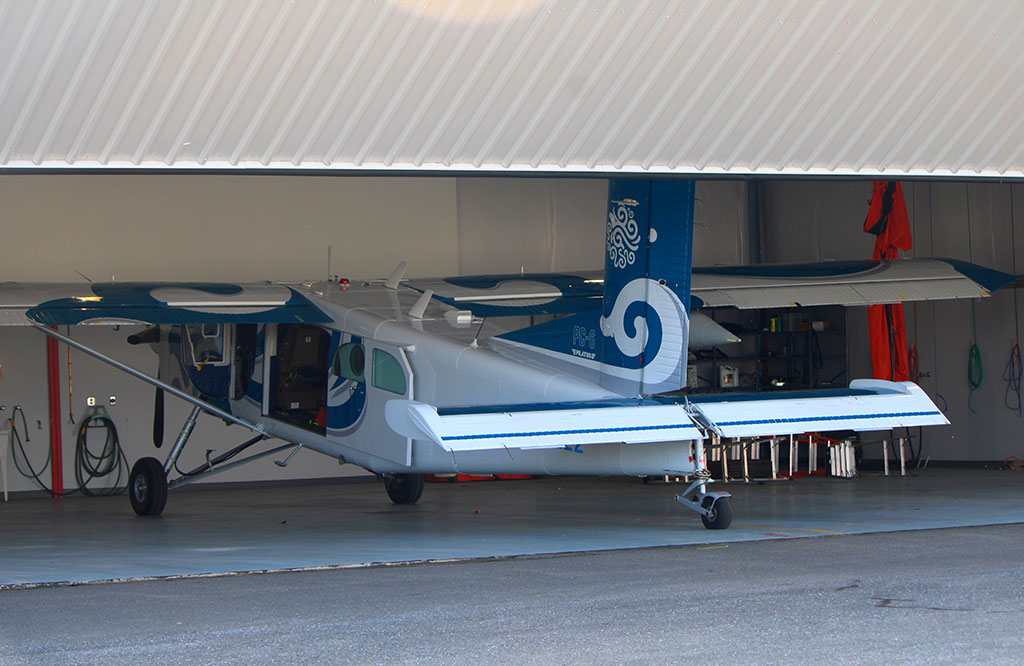
Mirabel Airport Friday 19th May: The curse of the hangar, episode two
This is the last day of our spotting trip and I am hopeful that we can go out with a bang as the itinerary not only includes a visit to Mirabel Airport in the morning, but also an afternoon spent at Trudeau Airport before our flight home aboard an Air Canada Boeing 787-9. With Mirabel being home to Nolanair, Pratt & Whitney Canada, a thriving cargo ramp and an Airbus A220 final assembly facility, there should be something for everyone?
I had written to Pratt & Whitney prior to our visit asking if we could have access to the Company hanger should the resident Boeing 747-SP not be parked in the open. Alas the Company politely refused, and alas the aircraft was indeed behind closed doors during our visit. This was hugely disappointing as we were just meters from the Company hanger and it felt as if the aircraft was calling out to me, clearly a sign that I had log-book fever! I am, however, reliably informed by Pratt & Whitney that the aircraft will feature in this year’s Air Show at Mirabel airport on Saturday 9th September.
The airport did in deed provide something for everyone, an executive ramp, a busy cargo ramp, and numerous Airbus A220 aircraft fresh off the assembly line awaiting delivery to their new owners including Air France and Jet Blue. The ramp that stole the show for me though was the one belonging to Nolinair which included 4 Boeing 737-200 aircraft, out of service Convair 580 C-FTAP and 3 Boeing 737-300 aircraft of newly formed OWG (Off We Go). OWG is a recently formed division of Nolinair offering flights to various Caribbean destinations from both Mirabel and Trudeau airports.
You can see the huge hanger doors of the Pratt & Whitney Canada facility in the photograph below, behind which I could only imagine the Company Boeing 747-SP was waiting to be deleted from my challenge list. Being this close brought back memories of when I flew on the type when visiting New York in 1990, making the return journey with American Airlines on former Pan-Am examples. This may come across as a prime example of the supremely obvious, but I remember boarding the aircraft, turning right and being amazed at just how much shorter in length the SP was compared to its larger sibling.
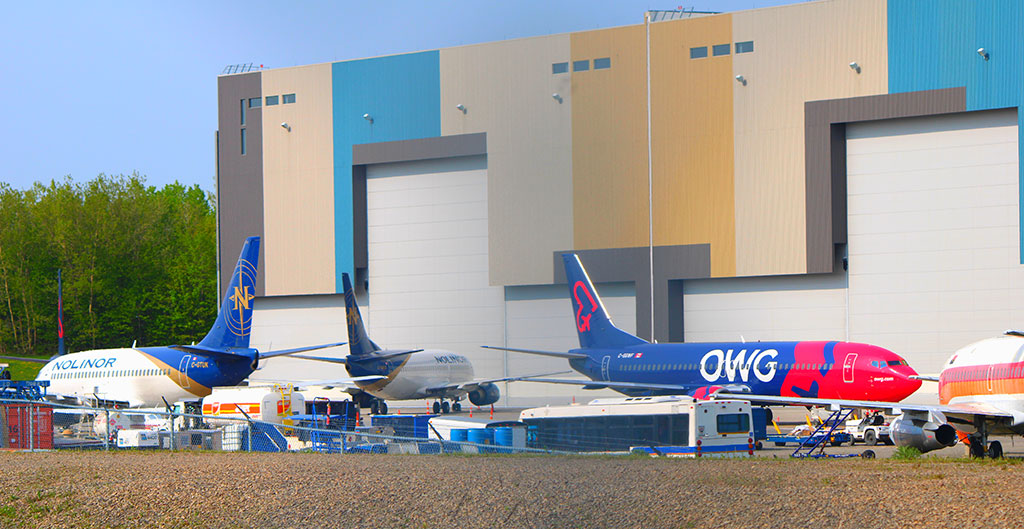
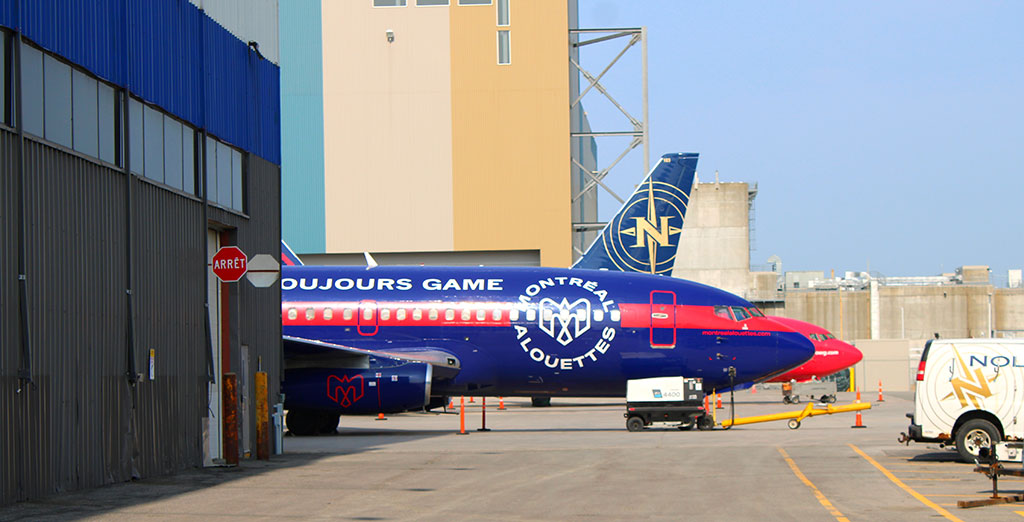
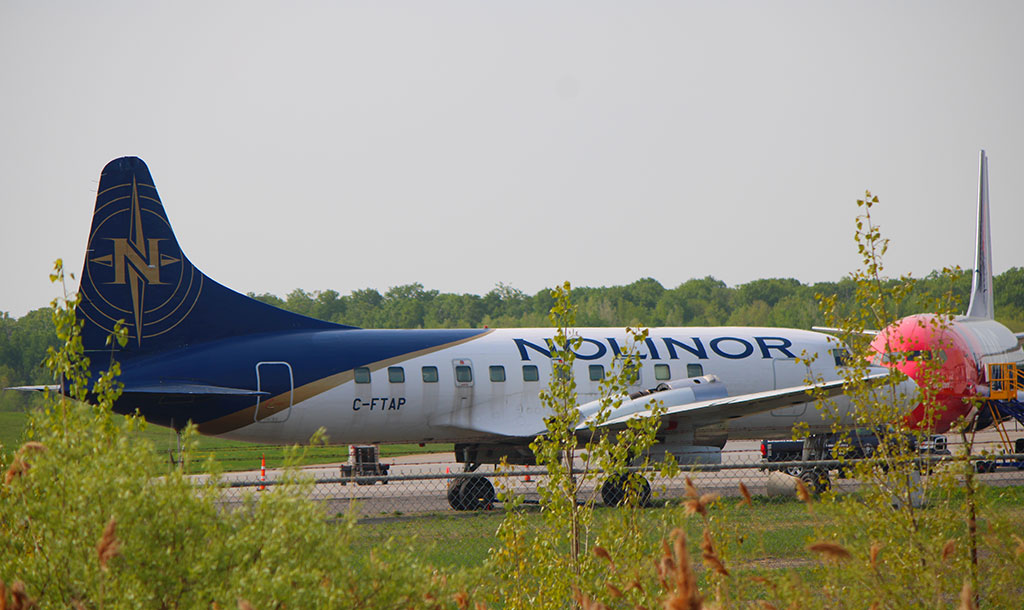
Today was the only occasion during our entire spotting trip that we had our “collars felt” by airport security. The personnel involved were most polite and courteous, and after having explained in detail the purpose of our visit, we were allowed to continue with our spotting activities un hindered. If visiting Mirabel airport, we would certainly recommend having a coffee in the Nolinair cafe which is suitably adorned with a wide range of aviation related memorabilia.
Trudeau Airport: Au revoir Canada
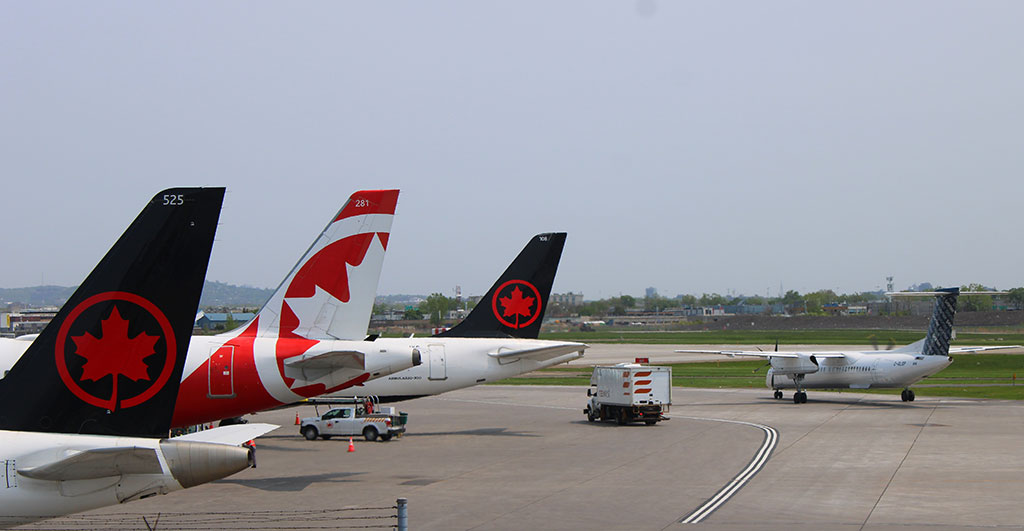
Before returning the hire car, we scoured the extensive array of perimeter ramps for aircraft that would not be visible from the main terminal building where we planned to spend the remainder of the day. Amongst the many aircraft we managed to truffle out between the numerous hangers was Glencore Canada Boeing 737-200 QC C-FFAL. Unfortunately, the aircraft was badly positioned for photograph purposes, only the tail was visible from our vantage point between airport buildings. Having missed a photo opportunity, the aircraft did recompense us later when it provided the ultimate “pinch me” moment of the trip.
Neil and I were clearing out the hire car before returning to the airport when the aircraft’s Pratt & Whitney JT8s were heard spooling up prior to commencing take-off not too far from where we were parked. What a beautiful sound, something I haven’t witnessed for a very long time and we both stood there smiling at each other whilst gazing at the aircraft as it rumbled out of site but not out of sound. This was probably my favourite spot of the trip, although the ST-27, SeaBee and Convair 5800 would certainly feature in a photo finish.
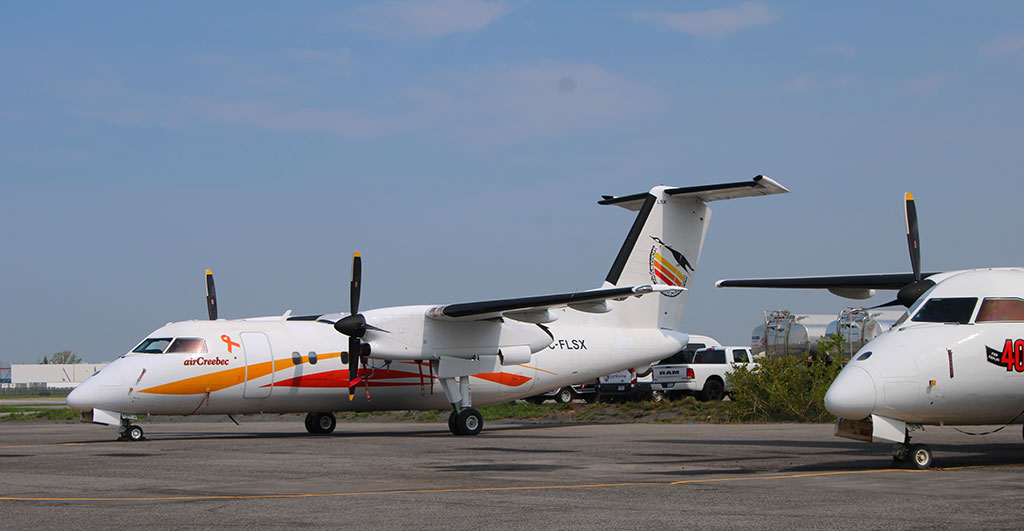
The Aircreebec ramp was busy with 2 DHC-8 100 parked up awaiting their next mission, and whilst we could not see the last 2 remaining Air Inuit Boeing 737-200s in the Company hanger we were graced with Boeing 737-300 QC C-GFFN. The perimeter tour also availed numerous Biz Jets for the ever swelling log book and all too soon it was time to return the car and check in for home.
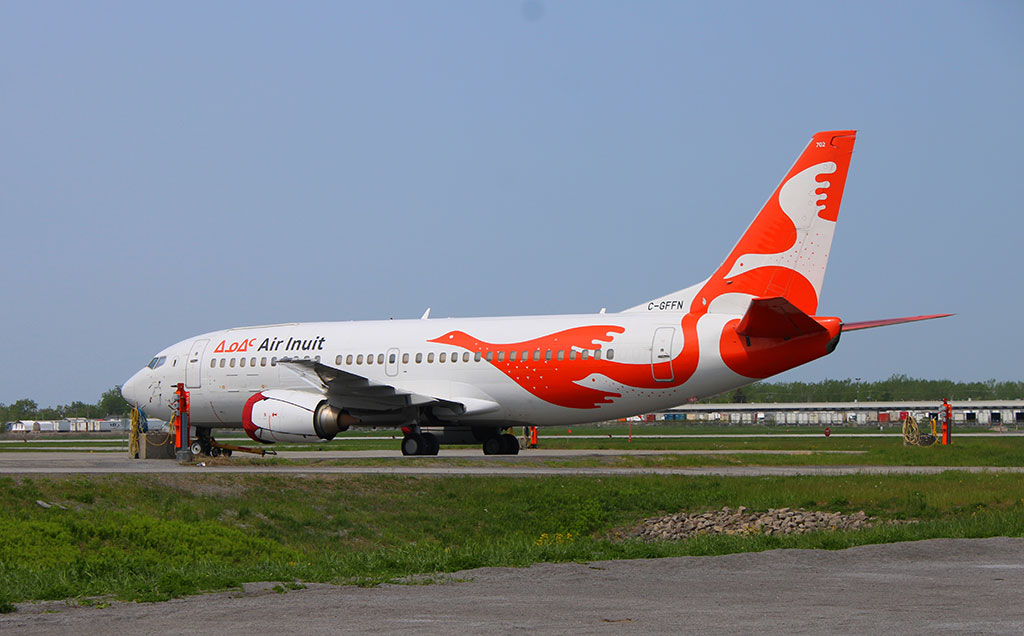
The log book master informs me that close to 100 aircraft were recorded during the 6 hours we spent at Trudeau airport, ranging from a Pilatus PC-9 through to an Airbus A350-1000 belonging to Lufthansa.
Conclusion
It is difficult not to be overwhelmed by the scale of the very special spotting “moments” enjoyed during this trip. What resonated most for me was the diverse range of aircraft types and genres that still carryout important roles in an industry largely dominated by shiny modern Boeing and Airbus jetliners. What also stood out was the number of small airlines operating not just from remote regional airports, but often cheek by jowl with the major airlines that dominate the main transport hubs.
On this trip I was fortunate to log;
- 34 new airlines
- 21 aircraft types required as part of my challenge
- 17 “live” Boeing and McDonald Douglas Classic jetliners.
Exciting spotting comes in many forms to different people, but for me North America still pushes the boundary as to what can be seen across such a wide spectrum of airports;
Motown; with its sophisticated supply chain model supported by Classic jetliners such as the Douglas DC-9, Boeing 737-200, Boeing 727-200, McDonald Douglas MD-80s and the ubiquitous cargo door adapted Falcon 20.
Northern Canada; with its remote mining and indigenous communities scattered across an immense landscape supported by a network of airlines operating small turbo prop aircraft often alongside “Quick Change” variants of Classic jetliners. It was a real treat to see a Metroliner still in use as a passenger aircraft and especially so belonging to the tantalisingly named Bearskin Airlines.
And finally, the vast “Lodge/ Cottage” holiday industry that is stoically supported by the many small utility and floatplane operators ferrying clients to and from remote lake side dwellings. I was reliably informed that over 600 DHC-2 Beavers are still active on the Canadian register, testament to a truly outstanding aircraft that has evolved throughout the last 70 years to serve different industries as time goes by.
I felt another chill in the air whilst visiting the Montreal airports, but this wind of change did not come in from the Arctic. A growing number of second generation Classics such as the Boeing 737-300 and McDonald Douglas MD 80 are being added to the Boeing 737-200, Boeing 727-200 and Douglas DC9 fleets belonging to Air Inuit, Nolinair, Chrono Aviation and usjet. This will inevitably lead to type churn in the not-too-distant future; my advice is to visit the airports highlighted on this trip before those “pinch me” moments are no longer around.
I went on this trip with the intention of making a rather large dent in the number of aircraft types still required as part of my challenge, and I succeeded. I had identified 23 qualifying aircraft, removing 21 aircraft from the list was certainly an achievement but I must confess to feeling a little disappointed on the flight home. I do feel as if the experience is similar to having been asked to name the 23 bands that you wanted to see during your life but admitting to have missed both the Arctic Monkeys and the Rolling Stones. The Boeing 747-SP will now have to wait until I visit California and unless I heed my own advice, I will need to visit the IOM to spot an Embraer Bandeirante.
Our spotting trip could not have been such a rewarding experience had it not been for the kindness and generosity afforded to us by so many airport and museum personnel that we met along our 7-day journey. From the free coffee on a cold evening at Sudbury airport to the close-up photography afforded us at Oscoda Wurtsmith and Bar River airports. I do hope that I am able to meet some of you again.
Finally, not forgetting my trip buddy Mr. Jones, who was first to draw his pencil each and every time an aircraft was spotted; a log master personified if I ever met one. As for the missing wallet, my money is on the likelihood that it remains wedged between his seat and the window and has clocked up more frequent flyer miles than any Air Canada passenger during the last couple of months. Should you happen to be seated in 23H on C-GHQQ in the near future, please do have a long hard look for the wallet and let me know if you find it, the cash left in the wallet will suffice as a suitable reward.
Au revoir, keep spotting and make sure you make every effort to see all the bands on your bucket list.
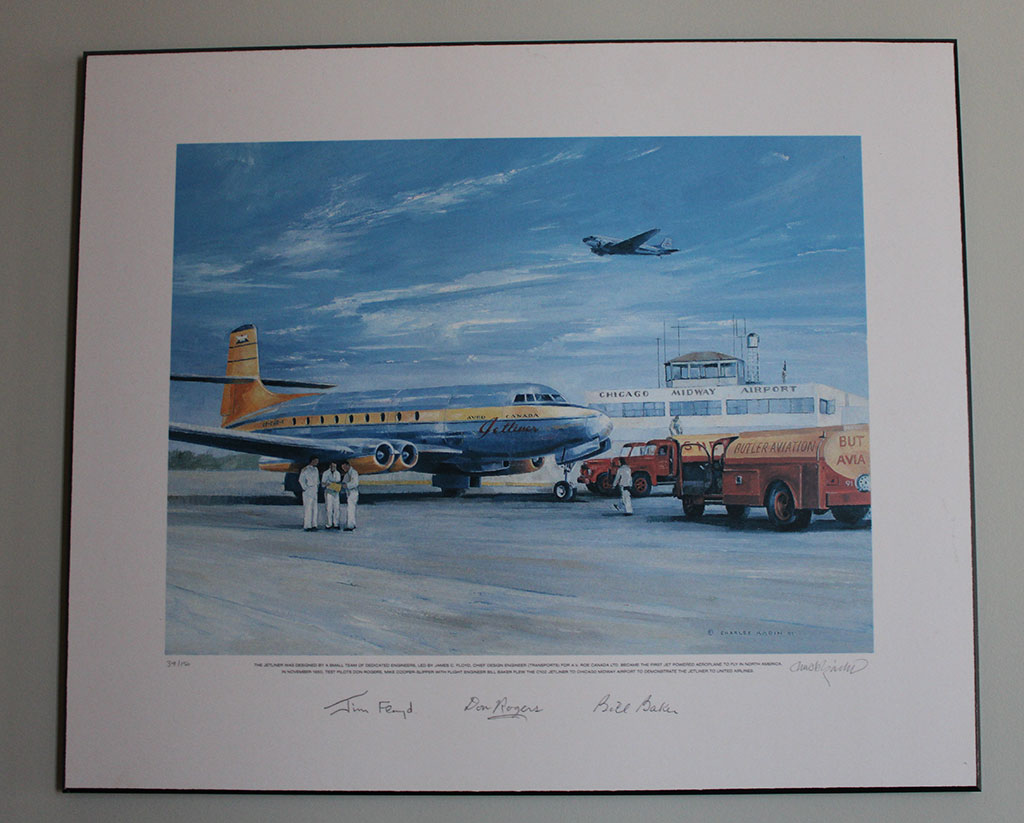
Canadair CL102 Painting. exhibited at Muskoka Airport

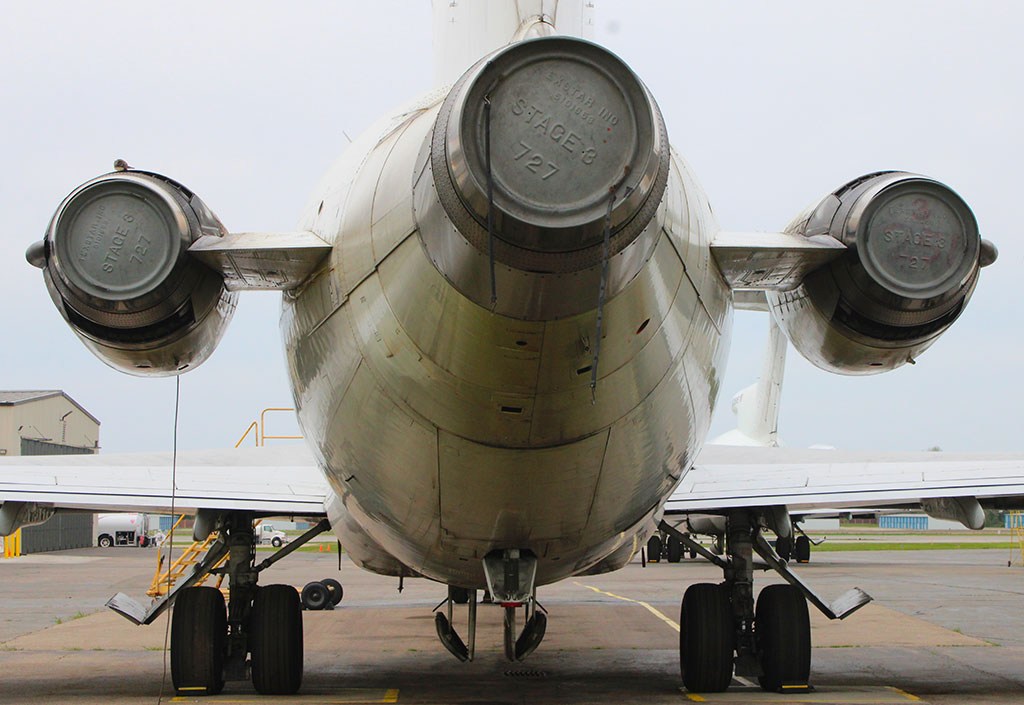



4 comments
Airbus A350-1000 belonging to Lufthansa
LH has no A35X in the flleet
Thanks Erik!
Good comprehensive report indeed, the Canadair C-4 and the Boeing 720 would have been my two highlights.
Have travelled around Canada a fair bit and as always I have enjoyed the terrific array of propeller airliners and bush aeroplanes. Have enjoyed seeing the DHC-5 Buffalo fly as well as heaps of Beavers, Otters single and twin, and the endless DASH 8 series and those very rare 737-200s.
On my first trip there in 1968, spent a day at the terrific Toronto downtown airport. Great memories.
Thoroughly enjoyed reading your exploit . Great indeed.